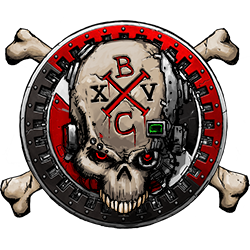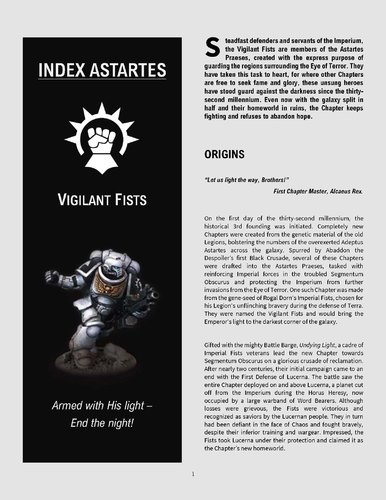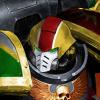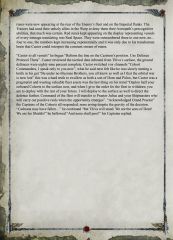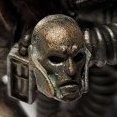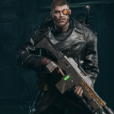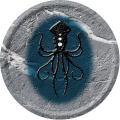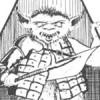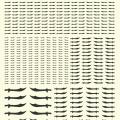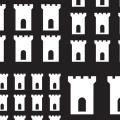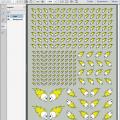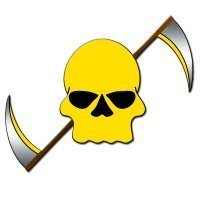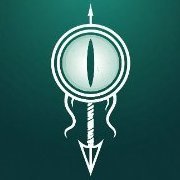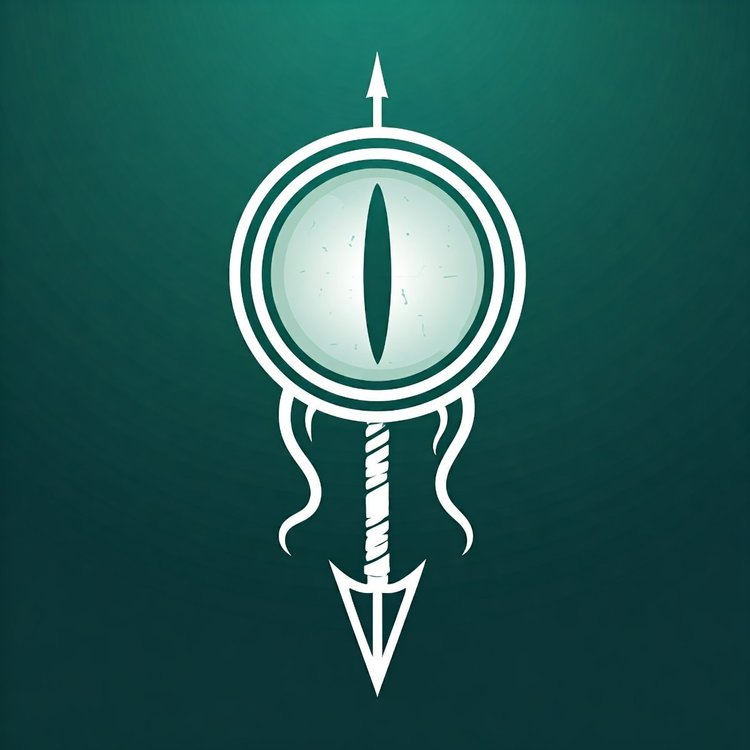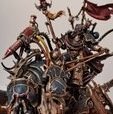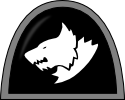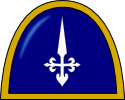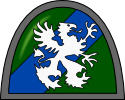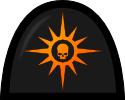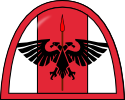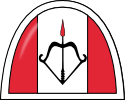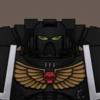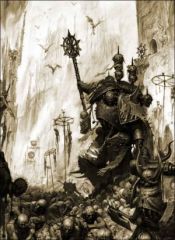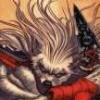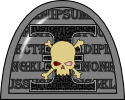Search the Community
Showing results for tags 'Index Astartes'.
-
Founding • Founding: Unacknowledged (believed to splinter from VIIIth Legion at Isstvan V). • Primarch: Konrad Curze. • Gene-seed: VIII Legion (Night Lords lineage, under Mechanicus oversight). • Chapter Master: High Count Malchior Veynar. • Fortress Monastery: The Nightfort. • Homeworld: Nostramorth. • Chapter Symbol: A bone skull bound in chains, black wings spread. Origins The Lords Penitent came about during the Horus Heresy, at the Drop Site Massacre on Isstvan V. When the traitors turned on the loyalists, the VIIIth joined the slaughter. The warrior who would later become the first High Count, Malchior Veynar, followed his brothers at first, killing loyalists, hunting them through the ash-choked canyons. He told himself they’d been betrayed, that the Emperor deserved this. But as he fought, he saw the truth. Horus wasn’t a saviour. Horus was the one damning them. Curze had fallen fully to madness. It didn’t matter what Nostramo suffered, it didn’t matter if the Emperor had abandoned them. Their oath still stood. Duty was duty. Horus was the traitor, not the Throne. At Isstvan V he and a fraction of his brothers turned their blades on their kin, siding with the Salamanders in the chaos. They scraped the old markings from their armour, carving in black skulls and wings, a mark of penance. They fought like they always did — from the shadows, striking terror — but this time it was against heretics. That was when they stopped being Night Lords and became something else. The Lords Penitent. The Salamanders, though wary, marked their actions and never forgot that these few had turned the night against Horus’ horde. Homeworld: Nostramorth Nostramorth is a storm-wracked world of near-perpetual night. The skies are thick with black clouds and constant lightning storms, its seas poisoned, its mountains cracked open like old wounds. It is a place of shadow, fitting for sons of Curze who still serve the Emperor. The people live under strict law. Crime is punished swiftly and publicly: thieves nailed to gates, murderers impaled, heretics flayed. It is brutal, but it keeps order, and the people accept it as part of life. They pray to the Emperor as the Eternal Judge, believing His light shines even through the storm-choked skies. Recruitment is just as harsh. Families sometimes offer their children willingly, walking them to the fortress gates and leaving them as offerings. The Lords Penitent also take orphans or those touched by crime. To be chosen is terrifying but seen as an honour — to live in penance, to serve the Judge Eternal. Fortress Monastery: The Nightfort The Nightfort is carved into a cliff-face above a poisoned sea. Towers stab into the sky like broken teeth, chained statues hang from the walls, and lightning lashes its spires. It was once a Great Crusade staging ground of the VIIIth Legion, abandoned after the Heresy, and reclaimed by the Lords Penitent as their home. Inside, the halls are lined with trophies — broken armour and bones of traitor Night Lords, but also xenos corpses. In the deepest vault lies their most infamous trophy: the charred, mutilated carcass of a Tyranid Norn Queen, chained upright as if still on display. In the Hall of Penance, captured traitors are given one choice: repent and die by the blade, or refuse and be executed as an example. Their armour, blackened and chained, is mounted on the walls as a warning. On the outer walls, the bodies of criminals are displayed — impaled, hanged, nailed. The fortress is more than a home. It is a message carved in stone and blood. Leadership The Lords Penitent are ruled by High Count Malchior Veynar, their founder, who has led them since Isstvan. He has not aged in ten thousand years, pale-skinned with black eyes and sharpened teeth. Some whisper he is a Perpetual, cursed to endure. Others claim the Emperor Himself wills him to live as judge eternal. He wears a trench coat over his armour, sometimes a dark red cape, and fights with twin power claws and ancient bolt pistols. Captured traitor Night Lords are brought before him. If they beg forgiveness, he grants them a swift death. If they refuse, he executes them as examples, their corpses displayed as warnings. Beneath him are the Counts, each leading a “Cell of Penance.” Chaplains serve as Confessors, Librarians as Justiciars, Apothecaries as Mortifiers, Sergeants as Scourge-Brothers, and Veterans as Wardens. Rivalries exist between Counts, but Malchior’s presence keeps the Chapter united. Combat Doctrine The Lords Penitent fight with shadows and fear. They strike from the dark, leave corpses on display, then vanish again. To them, terror is a weapon as sharp as any blade. Their greatest obsession is the hunting of traitor Night Lords. Every kill is another step toward redemption. Captured traitors are given one chance to repent. Those who refuse are executed and displayed, their armour chained on the fortress walls. They also wage constant war against the T’au Empire. Against the T’au their methods thrive — auxiliaries desert when their commanders are impaled, Fire Warriors falter when their leaders are flayed. Long-ranged ambushes and guerrilla strikes are their favoured style, ending in sudden, brutal close-range assaults. They are executioners, not generals. Beliefs They see the Emperor as the Eternal Judge. His will is law, His light pierces even the darkest storm. Curze is still respected as their father. They understand why he fell, but they know he chose heresy, and for that he is damned. They fight in his shadow, but not in his name. Rituals of confession and oath-taking are part of Chapter life. They also practice an older, darker method — consuming the flesh of slain foes. They claim it grants them fragments of memory and instinct. Whether true or not, it terrifies those who witness it. Civilians are the Emperor’s flock. They are protected, but kept in line. Justice is public and brutal. A thief might hang at the gate, a murderer impaled, a heretic burned alive. The people live in fear, but also faith. The Lords Penitents also have a belief that they must Hunt the Eighth legion, to either have them repent and realise that they have false loyalty like the High Count once did all those years ago or be exterminated. This is one of their major flaws. The Lords Penitent are never free of their father’s shadow. To them, hunting their traitor kin is more than duty — it’s an obsession. More than once they have abandoned campaigns to pursue a Night Lords warband, even when it cost Imperial lives. One such case was the Cleansing of Ceryx. The Penitent were ordered to aid an Imperial Guard regiment against the Orks, but when word spread that a splinter of the VIIIth had been sighted nearby, High Count Veynar diverted half his Chapter to the hunt. The Guard line broke, Ceryx burned, but the Lords returned with flayed traitor corpses nailed to their gunships. To them, that was victory enough. Gene-seed The Lords Penitent carry the VIIIth Legion’s curse. They suffer nightmares, paranoia, visions of doom. Some claim prophecy, others call it madness. Their eyes are black, like pools of midnight, a mutation that grants them night vision and adds to their monstrous reputation. Every brother must serve a century in the Deathwatch. It is both penance and proof of loyalty. Many die on alien worlds, their gene-seed harvested by the Mechanicus and returned to Nostramorth. Progenoids are implanted into vat-slaves, growing new warriors from sacrifice and service. Every Lord Penitent is born of death. A notable flaw of their gene seed are terrible visions, that have caused operations to go sideways. Notably the Sorrow Reach campaign, a Justiciar foresaw the enemy falling into an ambush if they pressed forward. Trusting his vision, the Counts threw their strength into the assault. Instead of heretics, they found an empty valley, mined and waiting. Hundreds of brothers were torn apart in the blast, whole Cells annihilated. Since then, the Penitent know their visions are not always divine warnings but can be false echoes, tricks of their tainted blood. Yet still they trust them, because they cannot help but believe. Rebirth When Guilliman revealed the Primaris project to the Imperium, most Chapters were granted reinforcements. For the Lords Penitent, it was different. The Inquisition and Mechanicus demanded proof that they could be trusted with such gifts. The surviving original brothers — those who had walked from Isstvan into ten thousand years of War — were offered the surgery first. It was not presented as a reward, but as a test. The operation was invasive and brutal, and many of them did not survive it. Those who did became something new — taller, stronger, yet still scarred by their cursed bloodline. High Count Malchior Veynar himself underwent the procedure. His Perpetual nature twisted the results, the new organs meshing with his old form in ways the Mechanicus could not explain. Some whisper that the surgery made him even harder to kill, though whether that is blessing or curse no one dares say. To the Lords Penitent, becoming Primaris is not glory. It is penance. The ritual of implantation is performed in the Hall of Penance, before the chained corpses of traitors. Candidates kneel in confession before the Confessors, swear oaths to the Emperor as Eternal Judge, and are cut open on stone altars to receive their new organs. Those who rise again are welcomed as reborn Wardens of the Chapter. Those who die are displayed with honour, martyrs to the cause of loyalty. Notable Campaigns • Isstvan V (Drop Site Massacre): The moment of their creation, siding with the Salamanders and turning their blades against Horus’ horde. • The Ashen Dusk Crusade: Against the T’au. Entire auxiliary regiments deserted after their officers were found flayed and impaled. • The Weeping Fortress: A traitor Night Lords stronghold was purged. Thousands of corpses were nailed to its walls. Their armour now hangs in the Hall of Penance. • The Vigil of Ke’lshan: Joint Deathwatch action. Even hardened xenos remembered the night raids of the Penitent with dread. Relations with the Imperium • Inquisition: Tolerates them, but never trusts them. Keeps them close for observation. • Ecclesiarchy: Uneasy. Their penance rituals border on heresy, but their faith is iron. • Other Chapters: Most distrust them. Raven Guard and Carcharodons see them as kin. Salamanders, though cautious, respect their stand at Isstvan. • Imperial Guard: Terrified of them, yet grateful when spared. To mortals, they are both saviours and executioners. Codex Appendix Founding: Unacknowledged (Isstvan loyalist splinter of VIIIth Legion). Chapter Master: High Count Malchior Veynar. Homeworld: Nostramorth. Fortress: The Nightfort. Combat Doctrine: Guerrilla strikes, executions, terror. Battle-cry: “Ave omnes, iudex aeterne!” Organisation: • High Count (Chapter Master) • Counts (Captains) • Confessors (Chaplains) • Justiciars (Librarians) • Mortifiers (Apothecaries) • veterans. • Sergeants. Side Note. Overall im happy with my Chapter. Proud of what ive done so far, i plan to add more eventually, more lore, rank insignias, create a picture of their look and chapter mark, assuming i can make a decent looking one.
-
- 1 review
-
- Codex Grey
- DIY
- (and 4 more)
-
Hey all, I've spent time this weekend writing my thoughts into a more coherent form. Still heavily WIP, but with nearly 4000 words I think there's enough meat here to get feedback from those whom are both better writers and more in-tune with the lore than I. Please let me know your thoughts! INDEX ASTARTES: TIMBERWOLVES The Timberwolves are a Loyalist Space Marine Chapter created during the Ultima Founding in response to a direct request by Inquisitor Ra’lesh for a protective Astartes force at the western edge of the T’au Fifth Sphere of Expansion. Initially made in haste from Primaris of various lineages to serve the immediate needs of the Canidae system, much of the original “Greyshields” force was decimated in the first T’au invasion of the tribal world Canilus before they could establish a foothold in the region. Only a miraculous, mysterious, assistance prevented the nascent force from being erased almost before it could be recorded in the halls of Terra as an official chapter. Through the subsequent rebuilding, the chapter’s genetic makeup has been established to be of Raven Guard lineage. The Timberwolves are one of the rare chapters who integrate with the local human population, its brothers sitting in council positions and heads of families in the local tribes from which they recruit. While maintaining an incredible stronghold on their home world, the Timberwolves also act partially as a crusading fleet, cycling battle companies between defense of their homeworld and crusading throughout the local region. CHAPTER HISTORY CHAPTER ORGANIZATION CHAPTER COMBAT DOCTRINE CHAPTER BELIEFS CHAPTER HOMEWORLD CHAPTER GENE-SEED NOTABLE TIMBERWOLVES CHAPTER FLEET CHAPTER APPEARANCE
-
From the album: Lore
© Games Workshop
-
From the album: IA & Short stories
-
- fanfiction
- liber astartes
-
(and 3 more)
Tagged with:
-
The following is a Work in Progress. INDEX ASTARTES - SIN EATERS Battle Brothers of the 3rd Company ID & HIGH GOTHIC: 0293 - COMEDENTIS PECCATI, "SIN EATERS" GENELINE: IX LEGION - GENE-DRIFT MINORIS FOUNDING: 2nd (CLAIMED), 3rd (SUSPECTED) DESIGNATION: PARTIAL CODEX COMPLIANT HERALDRY: SLATE & CRIMSON, GOUTE De SANG ON SILVER PALE CHAPTER FIEF: DUMAH, UPON THE STAR-FORT VINDICE STELLA MOTTO: AD VITAM AETERNAM, "TO ETERNAL LIFE" INTRODUCTION & PRE-HISTORY No man, bar the Emperor Himself, is beloved by all, not even a Primarch. All of the Astartes Legions, at least all for whom records remain contained those who chaffed at the changes made when they were reunited with their gene-fathers. Terran born, or traditionalist warriors who found the learned practices of their Primarch's adopted homes and cultures. Sub-legions and recon elements who missed the initial, ecstatic reunion, and never saw these larger-than-life figures in the flesh. Holdouts from an older, fouler war than the Crusade itself. The IX Legion were known, for a time, as The Revenant Legion. Eaters of the dead. Beautiful killers. Inheritors of names. These men who would in time become the Blood Angels left much behind when they were transformed by the Angel Sanguinius, when their hungers were tempered by a godling's grace. It was, for most, a revelation. Redemption. A chance to cast of a monstrous identity for something more noble. Or, to others, a false mask to hide their shame. A casting-aside of effective, sound battlefield practice that had marked them out amongst their cousins in the other Legions. A denial of their Emperor-given, transhuman edge. In other Legions such warriors often found themselves among the Traitors - or dead amongst the ashes of Isstvan III - or fighting all comers as Blackshields, but those of the IX who would eventually form the core of the Sin Eaters were loyal, to the Imperium if not their Primarch. Forced to deny their hunger, and a growing sense that they had been denied something more, they nevertheless fought throughout the Heresy, to the very walls of the Imperial Palace on Terra, and beyond. Only with the butchering of the Angel were they freed, and in the fires of the Scouring did they reformed themselves, reclaiming practices long-since forbidden. Like many quasi-independent Legion elements they were chosen to form new Chapters during the Second - Some records suggest Third, though the Chapter itself claims Second - Founding, Revenants beneath a new flag, Eaters of the Dead once more. Eaters of Sin. Brother Sergeant of the 3rd Company, a Lesser Immortal CHAPTER HOMEWORLD & FORTRESS MONASTERY Dumah is a cool, and shadowed world, thickly forested and mountainous, where it is not swallowed by vast and crushing glaciers. The human population, techno-feudal throwbacks abandoned in the distant past live in stone keeps that rise above the forested valleys and frosted peaks, kept warm by ancient generators deep within their bowels, sacred and ill-understood. War, of a sort, is constant. Warbands and raiders hunt each other between the trees, or engage in ritual battles in the few open clearings, killing each other of generational grudges, and stores to survive the long, harsh winter years. It is from this hardy stock that the Sin Eaters draw the largest single source of their recruits. Their Monastery, The Vindice Stella, sits in low orbit, a red star that passes above the peaks of Dumah, and has done for some 9,000 years. The ancient Star-Fort, left adrift in depths of space was captured by the Chapter in their earliest days, and placed above their chosen fief. Some 30% of their aspirants are drawn from Dumah, the rest from suitable human stock encountered on campaign. The Induction Sarcophagi utilized by most of the Blood Angels gene-line are capable of turning the twisted mutants of Baal into beautiful, strong astartes, and such technologies are put to good use by the Sin Eaters to allow for rapid recruitment while on the move, the various Company Fleets and Strikeforces more-or-less self sufficient, returning to Dumah to take part in Chapter-wide rituals and the sharing of heroic remains. Reclusiarch Hanuman, Chaplain of the Immortals CHAPTER ORGANISATION & CODEX COMPLIANCE Like many of their fellow Blood Angel successors, the Sin Eaters act largely within the tenants of the Codex Astartes, at least as it applies to battlefield strategies. Squad-level organisation and equipment, accepted skirmish-to-campaign strategic practices, all to be found somewhere within The Avenging Son's updated Codex, at least for the most part. Outside of the battlefield, however, divergence is found. The Sin Eaters do not keep a 10th Company. Instead, each battle-line Company is expected to raise and maintain their own initiates, and field scouts as required. This means that each Company often exceeds the usual size as dictated by the Codex, and the Chapter as a whole often doing the same. This is not without precedent amongst more mobile chapters, the needs of a specific long-term campaign leading Companies to swell their numbers when support from elsewhere is unavailable. If the Chapter, during a rare meeting of the Companies finds that it has grown too far beyond the 1,000 Marines stipulated in the Codex Astartes, a period of lessened recruitment is begun, and attrition allowed to return them to something closer to the limits placed on an Astartes Chapter. It has been some time since the last such meeting of the Companies. Ordo Astartes estimates place the Sector-wide count of Sin Eaters marines between 1,200 and 1,400 warriors, though their involvement in the ongoing 4th Tyranic war is expected to reduce those numbers dramatically. Leadership of the Chapter falls to the Immortals of the First Company, those Marines who have moved beyond death, becoming repeating patterns within the genetic memory of the Chapter, reborn in new flesh after the eating of the old. The Immortals, the True Immortals, form the First Company, and from there are assigned leadership and guidance of the Battle Line Companies, alongside fellow elites to act as bodyguards or force multipliers, forming a core of Crusade Fleets and Strikeforces. 'Lesser' Immortals, those not elevated to the First Company due to having not proven their stability to the Chapter Reclusium often lead squads within the Battle Line Companies, marked out by golden helms and personal heraldry not worn by those on their first, and likely only, lives. Immortals of the Blade IMMORTALITY & THE LAST REVENANTS The Omophagea - an organ common to all Astartes - is hyper-active among the sons of Sanguinius. The extent of this mutation has varied, over the millennia, though all from that line feel it to some extent. The urge for flesh. For blood. To the Blood Angels themselves this is a mark of shame, and curse to be warded against, but to their earliest ancestors among the IX Legion it was a gift embraced. To be able to gain intel from defeated foes through the eating of their flesh is an ill-understood practice to most Marine Chapters, one made use of sparingly. Not so the Revenants, who ate freely from the bodies of the fallen on both sides through the conquest of Terra. To them, it became a way of maintaining skills and memories of the Legion, dead warriors shared amongst their fellows, their memories imbibed. In some cases this allowed younger marines to quickly advance in rank, taking on the names and practices of those they had eaten. Ghastly, bad for the morale of allied human forces, but undoubtedly effective. The Sin Eaters have maintained this practice for 10,000 years, and in that time have learned how to coax those devoured memories to life. Their Omophagea has mutated further through repeated use, and the careful selection of desired traits by the Apothecarion. To be eaten by a Sin Eater is to be Known. Understood. Human foes are open to them completely, once their bodies are retrieved, and their own dead reclaimed for the genetic memory of the Chapter. All Initiates finish their elevation to full Astartes with a meal of the fallen, a final induction and training all in one. Stranger still are the Immortals. The genetic memory of the Chapter is strong, and certain individual consciousnesses, constructed from the devoured minds of dozens of fallen warriors stringer than most. These are the Immortals, those who have been reborn in fresh bodies when eaten, able to entirely replace the freshly hypno-indoctrinated minds of recruits, and return to the First Company clad in new flesh. These beings - or agreed upon delusions, as some within the Ordo Astartes claim - are by some measure the oldest 'living' Space Marines, with memory fragments dating back into the distant past, some for thousands of years. The re-embodiment of one of these Immortals is a grave and delicate task, overseen by both the Apothecaries and Chaplains of the Chapter. The body is retrieved, preserved in stasis, and made ready for devouring in total by a recruit selected for the task, one who has yet to taste their final meal, but is nevertheless complete and proven. They are watched and cared for during the potentially lengthy period of conversions, presented with items of their many lives, weapons and equipment, and finally allowed to return to service amongst their brothers, old eyes in a new face. The truth of the matter is difficult to discern, and harder still to ever truly confirm. Are they, as the Chapter claims, truly immortal beings within the genetic memory of the Chapter, born into new bodies through ritual and science? Or is this simply a more elaborate, and effective form of the 'spiritual' rebirth of officers in the days of the Revenant Legion, with fresh Astartes simply bolstered and aided by memories left for them by the lost? Who can say.
- 1 comment
-
- Sin Eaters
- Space Marines
-
(and 1 more)
Tagged with:
-
Version 0.9
160 downloads
The Bloodmoon Hunters are a stalwart and dedicated non-codex compliant Loyalist Space Marine Chapter created during the 13th Founding, the so-called 'Dark Founding'. This Downloadable Index is a Work in Progress to create a Supplemental Codex to use Bloodmoon Hunters unique tactics and formations in unofficial Warhammer 40k battles. In addition to capture their unique flavor and rules as they are developed.-
- Loyalist
- TechCaptain
-
(and 2 more)
Tagged with:
-
-
- Index Astartes
- Liber
-
(and 5 more)
Tagged with:
-
420 downloads
By request of Jape. The Marines Scimitar aka "Space Turks". Includes logo and background layers* in Black, 'Bone', Blue, Green, Red, Yellow, and White. (*Turn on the Layers palette in your PDF viewer to activate different colors. Only the topmost active logo and background layer will print, so be sure to turn off the color layers above the one you want printed.)-
- Index Astartes
- Space Marines
-
(and 2 more)
Tagged with:
-
- 1 review
-
- Black Castellans
- Space Marines
-
(and 2 more)
Tagged with:
-
-
- Index Astartes
- Space Marines
-
(and 1 more)
Tagged with:
-
-
- Index Astartes
- Templates
-
(and 1 more)
Tagged with:
-
THE VANQUISHERS Chapter: Vanquishers Founding: 4th Homeworld: Caeron Geneseed: Imperial Fists (Crimson Fists) Organisation: Codex Chapter Master: Coras Brenen Chapter Symbol: Silver Clenched Fist Brother Veneo of the Fourth ‘Resilient’ Company, Fifth Tactical Squad ‘Against All, We Endure’ The Vanquishers are a chapter that live and fight under the sacred tenets of endurance and vigilance, taking the trait of stubbornness and purity from their Primarch’s legacy. Renowned across the southern regions of the Segmentum Solar as masters of urban warfare, fighting in the treacherous conditions of densely built battlezones are their true forte in combat. Zones Mortalis, such as Hive Cities, industrial facilities and to a smaller degree, in the cramped conditions of void warfare are the Vanquishers’ true home of combat, forged through intensive training upon their homeworld of Caeron, itself a planet filled with crumbling Hive Cities destroyed during the Horus Heresy. Renowned for rarely retreating until the last glimmer of hope for victory is lost, the Vanquishers always seek to find an enemy’s weakness to exploit and turn the tide of a battle. Endurance is the trait above all else the Vanquishers strive for; ensuring that they outlast their foes through superior firepower and combat skills, no matter how long or protracted the campaign. This has sometimes led to the chapter receiving shocking losses in ill-fated campaigns, including their near annihilation in 398.M35 to WAAAGH! Gullzag on the Hiveworld of Azura Secundus, with only two hundred and twenty Vanquishers emerging from the apocalyptic clash, ending the Orks’ systemwide rampage. But the amount of victories snatched from the jaws of defeat by this tenacity has also provided the Chapter's greatest victories, such as the sundering of the Red Surge in 501.M38 in the Bryhod System. The battle brothers of the Vanquishers maintain a supremely high level of discipline both on and off the battlefield, it is remarked by some that their level of discipline is only matched and surpassed by their primogenitors, the Imperial Fists. Legacy and History Founding and Homeworld ‘This is the one true crucible where our vow and credo as a Vanquisher is tested and proven. As we break through the walls and buildings of this labyrinth; we must weather whatever craven trap and ambush awaits us, then execute our target. Against all, we endure!’ - Chapter Master Adilo Deinas at the Siege of Rimewall Hive, 370.M35 The Vanquishers were forged from the Crimson Fists in the latter years of 32nd Millennium, replacing the heavily depleted forces from the galactic wide rampage of the Orks after the War of the Beast. The chapter were dispatched to the Southern fringes of the Segmentum Solar to defend and eradicate the lingering Ork presence still left from the brutal warfare centuries prior. Captain Vasperon of the 5th Company was blessed with the honour and responsibility of building the new chapter, ready to scour away the Greenskin threat that was making its presence more felt through the Fidel Sector. Vasperon was a warrior who prided himself and his Company on pure will and unyielding vigilance for incoming threats when on and off the battlefield. This would be a major part in the creation of the Vanquishers personality and combat doctrine, as they grew in number and capability over the early years of the 33rd Millennium. Having successfully ended the threat of the Ork presence and building Waaagh! within the systems of the Fidel sector, the Vanquishers sought to find a planet on which to settle and build their forces to become a fully grown Astartes chapter. Located in the heart of the sector, the chapter settled upon the planet of Caeron, which was once a vibrant Hiveworld that served as a mustering point for the Expeditionary Fleets during the Great Crusade. When the Horus Heresy and subsequent events of the Scouring took place, the planet fell to the hands of the traitor Legions, until the Imperial Fists retook the planet in a cataclysmic campaign that rendered the planet a husk of its former habitability. A single Hive named Blackring, built after the Scouring now circles completely around Caeron’s equator, which remains the only viable area for humanity to survive with relative ease upon its surface; as to the north and south of Blackring, vast irradiated tundra wasteland spreads to Caeron’s poles, with long abandoned and crumbling hive cities, shattered orbital platforms and other infrastructure scattered across the hemispheres, which are almost impossible to reach by conventional means due to the violent storms and lethal environment created from the apocalyptic fighting during and after the Heresy. It is from these crumbling metropolises that the Vanquishers train their recruits to become the masters of combat in claustrophobic urban environments. Astartes of the Vanquishers often exceed the standard level of marksmanship with their firearms as a result of the rigorous, unrelenting drills performed within the ruins and environment beyond Blackring as reconnaissance and breaching teams. The Vanquishers’ vast Fortress Monastery, named ‘The Perpetual Sentinel' is based upon Caeron’s singular moon at its northern pole, Derev. The moon also serves as Caeron’s shipyard for trade alongside military repairs and deployment across its equator and southern hemisphere. The Fidel Sector and surrounding space has been an active region for the Vanquishers to constantly protect from xenos incursions, notably from Ork empires attempting to rebuild in a perpetual echo from the War of the Beast. The constantly elusive threat of the Agony’s Lash kabal of Drukhari have also persisted across the edges of the sector, where the twisted Xenos have conducted repeated raids over the millennia on the Imperial worlds and vessels within the region, despite the ferocious counter-attacks led by the Vanquishers when they receive their distress calls. The Fidel Sector is populated by a number of key worlds and systems on the southern edge of the Segemtum Solar, including a handful of Forgeworlds that the Vanquishers hold pacts of honour to protect when called for. As a result, the chapter holds a cordial relationship with the regional Martian forces, including the Titans of Demi-Legio Fluctus. The Fidel Sector also contains vital shipping lanes, including the relatively calm crossing of the Cinder Gap, located in between the colossal asteroid fields of two shattered planetary systems, created millions of years prior from an unknown force. The Gap provides a stable thoroughfare for resources to be transported towards Terra and the inner planets of the Imperium and it has been the Vanquishers’ duty to protect it ever since their founding. The Price of Endurance and Victory The numerous Campaigns, Crusades and battles the Vanquishers have fought in their eight-thousand year history is one that could fill entire Libraria across a single system. But as ever, their single-minded trait and credo of obstinate discipline to outlast the enemy and exploit their weak point in any theatre of war has been the root source of the fate of these thousands of engagements across the Fidel Sector and Imperium at large. Due to the after-effects of the War of the Beast, the Vanquishers have often focused their efforts on preserving order and thwarting any Ork Empires from growing into a sector-wide threat that could bleed out into the heart of the Segmentum Solar. The Ork strongholds of the Nallor System and the labyrinthine Keeve asteroid belt have remained a permanent stain of concern within the Fidel Sector. This waxing and waning xenos threat has been contained relatively effectively in the millennia following the War of the Beast. But this constant monitoring and resulting action has often been a source of whittling down the Vanquishers’ numbers from countering the greenskin threat, alongside the myriad other enemies of the Fidel Sector such as the Drukhari pirates plaguing the shipping lanes towards Terra. As a result, when a greater threat would strike the Fidel Sector, such as the Brass Skulls’ ‘Rampage of Gore’ through the region’s southern fringes during 081.M35, the Vanquishers’ would face serious losses to their reserves to end the threat. But as befitting their stubborn nature towards retreat and acting as walking icons of endurance, the Vanquishers have always rebuilt their number in an expeditious manner, recruiting from the various Hive Gangs and sundry upon Caeron and the various other worlds tithed to the Chapter within the Fidel Sector. A New Legacy When the 14th Founding of Astartes was declared, following the shrouded in secret events of the ‘Dark Founding’, the Vanquishers were honoured with the creation of a new Chapter from their geneseed and a retinue of Vanquishers would build this Chapter. Captain Talan Heru of the Second ‘Perpetual’ Company was chosen by the Emperor's Tarot to be its founding Chapter Master. Given the name ‘The Heralds of Dorn’ and clad in armour of gold and green, the Heralds of Dorn inherited the tenets of discipline and endurance from their parent Chapter, but after the redacted histories of the mysterious 13th Founding’s Chapters, the Heralds developed a zealous focus on purity above all else. This dogma extended not only to their doctrines of aspirant selection, but also to a stringent, unwavering adherence to the Codex Astartes. Being stationed in the eastern region of Segmentum Obscurus, it was a rare event that saw parent and successor fighting together on the same battlefield. But the Chapters’ annals do contain a number of key events where they fought as one. Notable examples include the Traxian Purges, as the brother Chapters broke the back of the ‘Goretoof’ Ork Empire, saving a dozen Sectors from what the Ordos Xenos predicted would be an unstoppable Imperial massacre within decades if the xenos were left unchecked. Their most recent event where Vanquisher and Herald fought alongside each other was the agonising Evacuation of Verdaur IV in 911.M41, Where the former homeworld of the Heralds of Dorn was subjected to Exterminatus, after the dormant Necron Tombs deep beneath the crust awakened and systematically purged all life present until the planet was reduced to a lifeless husk. After the dust settled and the Heralds of Dorn were reduced to half their number, they became a fleet-based Chapter, consumed in righteous vengeance against the awakening Necrons across the Segmentum Obscurus. To support their descendants as they sought to rebuild, the Vanquishers vowed to deploy one of their Battle Companies to aid the Heralds of Dorn in their duties until they had rebuilt to a viable number. The Third ‘Tenacious’ Company were the first to undertake this vow, their knowledge at dealing with the awakening Necron menace becoming invaluable upon their return in 942.M41. Similar followed with the deployments of the Fourth ‘Resilient’ Company to replace the Third, then afterward elements of the Fifth ‘Dauntless’ and Seventh ‘Resolute’ Companies in 993.M41. The fate of these sons of Caeron marooned beyond the Cicatrix Maledictum in Imperium Nihilus, after the 13th Black Crusade’s grave effects has remained an unknown mystery to the dismayed Vanquishers. They await their brothers’ return with hope, with the beacons of the Fifth and Seventh ‘Lanterna Vigilum’ towers of their Fortress Monastery remaining eternally lit, until their blades are returned to the Armorium. Brothers in Blood and Fist In the 39th Millennium, a new chapter of Astartes dedicated to void warfare was founded to reinforce the Vanquishers in protecting the Cinder Gap from raiding pirates of Drukhari and other threats. This stemmed directly from the ill-preparations of the Fidel Sector as a whole, caused by the colossal bureaucracy of the Imperium, leading to ‘WAAAGH! Snazklaw’ rampaging across various systems. In the subsequent decades, territory reclamation and Ork cleansing became a primary focus for the Vanquishers’ forces alongside rebuilding their numbers, which allowed ample opportunity for pirates to reap terror and claim their treasure with relative ease. Forged from Sanguinius’ sons, the fleet-based ‘Emerald Tears’ became a closely bonded Brother-Chapter to the Vanquishers over the following millennia. This grew in-part from an excellent interlocking of the Tears’ fierce and aggressive oriented void-warfare with the methodical, brutal practices of the sons of Caeron when fighting together in numerous campaigns. Declaring a bonded pact, known as the ‘Seraph-Gauntlet Alliance’, the two Chapters would work near perfectly in paired concert on campaigns in retaking or breaking the siege of worlds and systems, with the Emerald Tears’ mastery of ship-to-ship void warfare annihilating enemy vessels to allow the Vanquishers to deploy their forces within the fortresses or cities that required breaching planetside. One notable acclaimed event was the destruction of the Drukhari Pirate, K’hryth Vexaris and her distinctive Ebon-Glass fleet, where the Emerald Tears baited the corsairs to attacking a spurious fleet of merchant vessels, which in reality were empty, bar the ships’ Servitors. Once the trap had been sprung, the Tears’ harried Vexaris’ ships into the Anthracus Web asteroid field. Within the vast detritus of shattered worlds, the fleet of the Vanquishers lay in wait until they struck a mortal blow, annihilating the Drukhari vessels in a pincer of unrelenting firepower and the shattering of nearby asteroids rigged with charges. None of the Drukhari Pirates, or their vessels escaped the righteous justice of fury from both Chapters. The Galactic Schism As the final years of the 41st Millennium waned and the Astronomican grew weaker, the Vanquishers found themselves severely hard pressed as Ork empires grew in power within and beyond the Fidel Sector, notably WAAAGH! BlakkHamma, requiring a major splitting of their forces to multiple war zones, including the deployment of their Tactical Reserve Companies to stem the growing green tide. The Cicatrix Maledictum's tear across the galaxy added a nuclear payload into the fires of conflict across the sector, as uprisings, dangerous psychic awakenings and Chaotic incursions sowed the seeds of outright warfare and anarchy across the many systems the Vanquishers protected. As the attrition of these campaigns began to wear the Fidel Sector’s Imperial forces numbers down, rebellions and more uprisings began to appear, grown from the desperation of the citizens’ being forgotten and Xenos incursions became increasingly prevalent. Requests for reinforcement fell upon deaf ears on Terra as the madness of the Warp’s new tear split the Imperium in half. When the Blood Angels had called for aid at Baal, the Emerald Tears sought to answer; but as the tides of the Greenskin overwhelmed the Vanquishers forces, leading to dire casualty numbers, the Tears chose to send only two squads to Baal. Seeing the value of keeping the Fidel Sector safeguarded due to its proximity to Terra and the supplies travelling through, the rest of the Emerald Tears remained to reinforce and aid the Vanquishers. Fall of the Emerald Tears In spite of their heroic and selfless decision to remain and protect the Fidel Sector alongside their beleaguered brother Chapter, the fate of the Emerald Tears ended in tragedy. A cataclysmic scenario formed, where a dangerously weaponised Ork Space Hulk, dubbed ‘Da Krump Krooza’ was heading for the vast population centre of the Hurst Cluster. The Tears fought to the last aboard the hulk, preventing its true power from bringing catastrophic ruin to the region. Their efforts in breaking the back of the Ork forces aboard Da Krump Krooza allowed for the Vanquishers to purge any greenskin remnants present and recover what wargear and geneseed they could of their fallen cousins. Following this noble task, the Imperial Navy and Vanquisher ships reduced the Space Hulk into a colossal debris cloud at the edge of the Tybarn System. It became a bitter irony that the Indomitus Crusade would arrive scant years later, too late to reinforce the honoured fallen sons of Sanguinius, but the Vanquishers honoured their passing in carrying marks of the emerald teardrop upon their armour for those who had fought beside them, carrying their name in memory and in the wargear recovered in the wreckage of Da Krump Krooza. When elements of the Indomitus Crusade finally arrived to relieve the beleaguered forces of the Vanquishers, the introduction of the Primaris marines as reinforcements, alongside their new wargear was initially seen as an affront to the proud chapter that emphasised and held strong on the tenets of endurance. The Primaris were perceived by many Vanquishers as their replacements, and First-Born Astartes were now to be forgotten and considered no longer worthy to carry out their duties. But over time and through counsel with the Primaris that were tasked with reinforcing the Vanquishers, it became abundantly clear that this was an enhancement to the chapter and the displays of fortitude and sheer will of their new brethren proved they were true sons of Dorn and the Vanquishers. Over time the numerous threats began to reduce in the Fidel Sector and a fresh chapter of Primaris marines, the Viridian Angels took up the burden of the fallen Emerald Tears. To help forge the new bonds of brotherhood and duty between the two Chapters, the most sacred of relics recovered from the fallen Emerald Tears, including the ‘Lance of the Seraph’, once wielded by their Chapter Champion were gifted to the Viridian Angels alongside inheriting the former homeworld of the Tears, Lacrivia III. In the current era, the Fidel Sector has much left to cleanse and purify from the Great Rift’s formation and Noctis Aeternam, but the Vanquishers continue to look ahead to face the challenges and endure all that the enemies of the Imperium can muster. Combat Doctrine and Organisation "Urban warfare is the ultimate test of a warrior's skills. To fight in the claustrophobia of ruined buildings, where danger waits around every passage, every corner, from above your head and beneath your feet. An Astartes must be as vigilant as his spirit can muster. His weapons must be gripped tighter, always ready to strike. His reaction times must reach a point rivalling the preternatural. We have been raised to fight in this environment. In the ruins of Ashenhive, Skyreach and Tridenthaven, every son of Caeron has honed their skills against each other and the cruel monsters within the shadows of the once almighty buildings. The battles of legends may be imagined upon open fields, but we fight the reality of the ultimate test of combat." - Veteran Sergeant Alato Karvan of the Resilient Company to a White Talons veteran, during the defence of the Felwinter Hive Complex. Command Retinue Chapter Master Coras Brenen - Lord Protector of Caeron Captain Marek Tarren - 1st ‘Praetorian’ Company Master of the Crusade Captain Sontor Arral - 2nd ‘Perpetual’ Company Master of the Fortress Captain Fernann Cohr - 3rd ‘Tenacious’ Company Master of Arms Captain Elias Draeg - 4th ‘Resilient’ Company Master of the Fleet Captain Valdor Antana - 5th ‘Dauntless’ Company Master of the Marches Captain Synas Castor - 6th ‘Steadfast’ Company Master of the Rites Captain Deinar Orhon - 7th ‘Resolute’ Company Master of the Trials Captain Kaspar Gehr - 8th ‘Relentless’ Company Master of the Breach Captain Argus Salazar - 9th ‘Perennial’ Company Master of Bombardment Captain Martel Kydio - 10th ‘Hidden’ Company Master of Recruits A staunchly Codex chapter, the Vanquishers loyally follow its tenets and rarely divert wildly from its teachings, with exceptions to the name of certain ranks and Captains’ titles in some of the Companies to fit their style of warfare. Chapter Master Vasperon decreed that each Battle Company should also carry a title that describes endurance and defiance to remind the Vanquishers of the tenets and traits laid down since their founding millennia ago. The only exceptions to this naming were the First ‘Praetorian’ and Tenth ‘Hidden’ Companies, befitting their own role within the Chapter. The Vanquishers’ prime talents in prosecuting urban warfare or combat in similar confined Zones Mortalis will often see them deploying to wars and crusades that desperately require their expertise. In more protracted campaigns, the chapter will often seek to ensure that the enemy is forced or directed into combat within such environments to increase the Vanquishers advantage over them. But when called for, the chapter are more than capable of fighting in the open battlefields beyond their favoured urban confines, some of their finest victories in combat have been executed in these moments, such as the Second Sunrise Assault during the Lauss Rift Campaign of 982.M41. With the advent of the Ultima founding, the Vanquishers adapted to their newer armour and armaments quickly. The Chapter now ensures that within their Company structure, the Lieutenants are one Primaris and one First-Born Astartes to keep stability and balance and share the capabilities of both styles. 'Wallbreaker' Formation The Vanquishers utilise a number of unique formations to breach well-fortified enemies in urban campaigns. One that has become synonymous with the chapter is the Wallbreaker Formation to breach bunkers and buildings. Company Veterans carry vast storm shields, first used in ship to ship boarding assaults during the Great Crusade and wield storm bolters or special weapons to clear out the enemy, after having been breached an entrance from a heavy weapons squad or vehicle. In recent decades, Hellblasters and Eradicators have been a very popular option for breaching, with their veteran brothers leading them in to clear the enemy out, with their Hellbasters or Eradicators ensuring that no heavier resistance stems the oncoming wall of ceramite. In the tight confines of these urban environments, none can escape the Vanquishers’ wrath. Having moulded their combat style to capitalise on fighting in the cramped and unpredictable nature of urban and industrial environments, alongside dealing with the Ork menace that constantly threatens the Fidel sector as it rebuilds; the Vanquishers often deploy wargear designed for this purpose, including the heavy use of flamers and meltas for breaching buildings and their combi variants there-in. The chapter boasts a higher number of heavy vehicles than considered the norm for a Codex chapter as well, designed to aid them in their campaigns in combat on industrial and hive worlds, this includes a plethora of Vindicators and Land Raider Redeemers. The newer Phobos pattern of power armour has been greatly accepted and utilised strongly by the Vanquishers’ to befit the tight confines of urban warfare they typically prosecute. The use of Infiltrators and Incursors has become commonplace for the newer Primaris sons of Caeron alongside the chapter’s Scout squads to gather intelligence and commit more covert operations before attacking in full force with their armoured might. Whilst the chapter does possess an ample amount plasma weaponry, it is not fielded as often by regular units of Astartes, due to the nature of the Vanquishers’ more prevalent combat campaigns in the tight confines of urban conflict, where plasma weaponry can pose a danger to the wielder and his brethren should it overheat. But Astartes that do carry the responsibility or choice to wield plasma weaponry into combat, notably in the Vanquishers’ famed ‘Wallbreaker Formation’ squads, are viewed with a wary respect by their kindred. With the addition of the Hellblasters, the view on Plasma weaponry remains relatively unchanged, but the level of respect for their newer brethren to wage war with such powerful and dangerous weaponry continues to be very high. To utilise such destructive power at your own risk, to ensure that the enemies of the Vanquishers are eradicated is a sacrifice worthy of Dorn’s legacy. Astartes of the Vanquishers typically eschew adorning their armour with overly ornate decorations, viewing them as hindrances in the tight confines of urban warfare. Some exceptions are however included, such as the Iron Halo and cloaks of Office for Command. Typically, a battle-brothers honours are laser-etched and painted into their armour as an honour shield, which can be placed wherever they deem fit. Veterans who wield Storm and Combat Shields place the honours onto their weapons instead, displaying their honours without hindering their armours movement. Having been founded in the earlier millennia of the Imperium after the Horus Heresy and Scouring, the Vanquishers still hold a large amount of older marks of arms, armour and vehicles that were gifted to them by their primogenitors and the Mechanicum. Some very rare, near singular examples of the ancient super-heavy battle tanks from the Heresy and Scouring, such as the Sicaran and Fellblade also reside within the armoury deep beneath the soil of Derev. These sacred armaments and relics are suitably revered by the Techmarines and chapter at large and the choice to deploy them into campaigns is only sanctioned by the Chapter Master or Master of the Forge. The Vanquishers possess a fair amount of the newer firstborn Mark VIII ‘Errant’ power armour from the Adeptus Mechanicus Forges, with their other armour, including the Mark X variants worn by their Primaris brethren often including up-armoured additions in vulnerable areas to aid them in combat. It is a common practice to also add additional sensors and scanners to their armour’s systems where possible, to ensure that a Vanquisher holds the upper-hand in urban combat. The Mechanicus sometimes rankle at the adjustments made to the sacred suits, but the Vanquishers’ history in saving Forgeworlds from destruction and the reverence they hold for their older relics from their founding era have stayed the Mechanicus’ abhorrence to such changes. Recruitment The Vanquishers have a number of sources for replenishing their ranks, which has been more prevalent than ever following the events at the end of the 41st Millennium. Their homeworld is their greatest reservoir of recruitment, but they also claim tithes to a number of other worlds in the Fidel Sector, enacting Recruitment Orders as they see fit. Upon Caeron itself, the chapter primarily source their novitiates to undergo the deadly process of becoming an Astartes from the numerous Hive Gangs that reside in the depths of the equatorial Blackring Hive upon their Homeworld of Caeron. Although the world is very much under control and loyal to the Imperium, its sheer size and the inhospitable conditions beyond the edges of the equator means that there is plenty of criminal and violent activity where new, young recruits can be sourced. Oftentimes these new recruits are press-ganged directly from arrests made the the planetary Arbites and Planetary Defence Forces, given the choice to serve and find redemption and purpose as a Vanquisher, or be executed. This source of recruits is an ideal start for the Vanquishers to build upon their speciality of Urban ‘Zone Mortalis’ Warfare as they ascend through the ‘Trials of the Gauntlet’. A smaller number of recruits are also sourced from the extremely deadly wastelands surrounding the ruined Hives and eroding settlements, where nomadic caravans eke out a living beyond the harsh strictures and control of Blackring Hive. Many of these recruits are volunteers who wish to escape the harsh, short lives of the wastelands. These neophytes prove to be a hardy stock, able to withstand the gruelling training and augmentations required to ascend to an Astartes. Once the various tests of purity in a novitiate’s biology, psychology and psychic capability, the Vanquishers follow a similar style of advancement through the stages of becoming fully fledged Astartes as other sons of Dorn who follow the Codex Astartes. Training these novitiates, alongside regular live-fire exercises the Chapter performs occurs primarily in three of the ruined, eroding Hive Cities that exist upon the shattered surface of Caeron. These are the now dangerous ruins of Tridenthaven, Skyreach and Ashenhive, which were all subjected to punishing bombardments during the events of the Scouring. Within these ruined Habs, Manufactora and Barracks, the Vanquishers train their recruits ruthlessly in the arts of close-quarters combat and tightly-disciplined firearm drills. But this is only done once these young recruits prove their worth through trials of endurance, be it long runs through the lethal walkways and passages of the ruined Hive Cities, or in prolonged duels against other recruits and combat servitors. The tenets and credo of endurance in all things is indoctrinated into the neophytes from the very beginning of their training. This increases as the recruits advance further along their training and as augmentations are inserted into their bodies. By the time they graduate from the 10th ‘Hidden’ Company, each and every one, alongside being blessed with the Black Carapace, maintain a fervent outlook and embodiment of the Vanquishers’ motto, ‘Against all, we endure.’ Once the Black Carapace has been fully integrated with the newly ascended Vanquisher, they participate in a sacred ceremony within the halls of their Fortress Monastery’s Reclusiam. In the Cathedral of the Honoured Souls, these new Vanquishers have their names engraved upon the hundreds of pillars upholding the gargantuan halls. To mark their eternal service and vow of being true to the creed of the Vanquishers, Rogal Dorn and the Emperor, these new Astartes cut their hands and fill the recesses of their engraved names with their own blood, sealing their honour-bound vow. +++++++ Well it has been a while but I've been quietly refining some old IAs in these new-fangled Google Documents (transferring them from the old style of the board to this iteration's a good challenge) and I've been lightly refining my second army which has seen a few iterations here, the Vanquishers chapter. I've added some new editions on them having a successor chapter (finally fulfilling a vow to Heru Talon in using the Heralds of Dorn) and adding Recruitment. It's definitely getting close to full completion, but I'd welcome any and all input on how it looks and also as to what else do you feel needs to be included. Thanks for having a look see! Cambrius
- 3 replies
-
- Vanquishers
- Vanquishers Chapter
- (and 5 more)
-
+++INCOMING TRANSMISSION+++ +++FID Indicator - ALPHA+++ +++Via Astropath 7NBS2069LVP1+++ +++Via Astropath 8849042+++ +++Via Astropath 100496-B7+++ +++Thought for the day: Do not wait for death.+++ +++Begin message+++ My noble and revered cousins of the Legio, Attached for your consideration, you will find a datafile containing the summation of the noble and resolute Astartes Chapter, the Sanguine Gargoyles. It is a most esteemed honor to have been entrusted with compiling this Index, with the hope of inclusion in the Liber Astartes. Within the datafile you will find my own annotations; please forgive my additions, but I do not feel my Librarium staff quite captured the soul of my beloved Chapter, and I felt the need to elaborate and explain certain aspects I felt were noteworthy. Once again, I humbly thank you for the opportunity to honor my Brothers in blood and arms of the Sanguine Gargoyles. May the Emperor ever watch over you. Your humble servant, Pellegrino Tempest-wright of the Sanguine Gargoyles +++Begin Datafile+++ Index Astartes: Sanguine Gargoyles "May your soul be cleansed by the rain." Index Astartes Chapter Datafile [INSERT CHAPTER EMBLEM HERE} CHAPTER NAME: .............. Sanguine Gargoyles PRIMOGENETOR: .............. Sanguinius GENE-SEED (PREDECESSOR): ... Blood Angels (IXth Legion) FOUNDING: .................. 21st, 991.M35; Ultima, 999.M41 [Rebirth] CHAPTER MASTER: ............ Lucian, Chapter-wright and Master of Pandemonium HOMEWORLD: ................. Fleet-Based, semi-nomadic SEGMENTUM: ................. Obscurus FORTRESS MONASTERY: ........ Pandemonium, Forgeship COLORS: .................... Dark stone gray w/ dark crimson right shoulder pad SPECIALTY: ................. Terror, Guerilla Warfare SUCCESSORS: ................ None STRENGTH: .................. Unknown (estimated to be nominal to above strength) BATTLE-CRY: ................ "For Sanguinius!"/"We avenge the Angel!" The steadfast warriors of the Sanguine Gargoyles Chapter stand amongst the ranks of the Emperor's finest, ever ready to deliver His wrath and justice upon those that would seek to subvert the Imperium. Origins The First Millenium When: 992.M35; 21st "Cursed" Founding Why: Strategic Prgonostication Founded as Saviors of the Chalice Captain, Chaplain, Librarian, Sanguinary Priest, five Veterans, Veteran Sergeant and ten Marines permanently seconded as training cadre The Aerie Fortress Monastery on Bowden IV Bowden IV destroyed in Gothic War Battle Barge Light of the Angel used as de facto fortress monastery until new homeworld can be found Friends and Enemies The Mutant Gene-seed manipulation by Mechanicus to remove progenitor flaws appears successful at first, but is later seen to have made genetic flaws devastatingly worse Genetic instability leads to weakening of chapter's forces Death of a Chapter Gothic War - Most of chapter lost in destruction of homeworld Less than 200 battle-ready Astartes left Remaining forces give up on finding new homeworld, decide to embark on crusade until they are destroyed or the chapter is rebuilt A Chapter Reborn Chapter gene-seed is stabilized with help from Mechanicum and Blood Angels' Brother Corbulo Primaris reinforcements from Guilliman's Unnumbered Sons Some Firstborn undergo the Rubicon Primaris, many do not; those who remain Firstborn continue to experience exacerbated genetic mutation New Primaris forged with stabilized gene-seed lift the chapter out of the ashes of death and into Chapter is reorganized to make best effect of new troops and Guilliman's new strategic force organization Voidborne Mechanicus gift the chapter a forgeship Geneseed Progenitor: Blood Angels Purity: Flawed Data archives list the known, stable, gene-seed mutations the Sanguine Gargoyles currently suffer from. No known cure or treatment for any of them has been found thus far: Melanchromic Organ Malfunction [Some Astartes' skin bears grayish discoloration; severe cases have stone like growths over large portions of their bodies.] Mutated Catalepsean Node [This causes what is effectively extreme insomnia; all members of the Chapter suffer this mutation.] Non-Functioning Betcher's Gland [All members of the Chapter suffer from this mutation, as well as calcification of their vocal cords, which appears to be one side effect of the mutation. However, the severity of calcification varies widely from one brother to the next. One might be unintelligible when he talks, nothing but the sound of cascading rocks or rushing water issuing from his throat; another might simply have a rich baritone voice; a third might offer a barely audible whisper.] The Apothecarion and the Ordos Biologis have been unable to decipher why only some members of the Chapter suffer certain mutations while others don't. But hope still remains that a solution might be found, for once every few generations, a battle brother suffers none of the Chapter's genetic mutations. Fleet-Based Fortress-Monastery: Forgeship Pandemonium Recruiting: tithe agreements (demands) from saved worlds/systems as primary source of new recruits; small number of volunteers from within fleet taken as supplemental recruits; kidnapping all children, ages 5-13, from an entire planet as emergency source of recruits (also used as a punishment against a planet in some circumstances) Beliefs & Culture Chapter Beliefs: Revere the Primarch Daily meditations include prayers to Sanguinius for guidance, thanks, and forgiveness "Sanguinius blesses you," "May the Angel guide your body and mind," and "I offer my actions to our father Sanguinius that he might judge my soul," are common benedictions heard throughout the Gargoyles' fleet. Against the forces of the Black Legion, the Gargoyles fly into an almost murderous rage, eager to exact revenge from every single traitor legionnaire. Characteristic Chapter Training: Mens et Manus This chapter believes in building their brother's minds and bodies to peak performance, the better to be ready for anything. Demeanor: See But Don't Be Seen Armor is matte where possible, and appears chiseled from stone rather than forged of metal; overall appearance of statues when standing still Flaw: We Stand Alone Will only request support from other descendants of the IXth Legion except in the most dire of circumstances Will offer aid to those in need, but will disappear without word Will not fraternize with anyone outside the Chapter, even other Chapters of Sanguinius' line; will not even remove helmets around outsiders, except under very exceptional/dire circumstances Angel Graces/Warrior's Virtues The Gargoyles strive to embody the Graces of the Angel and the Virtues of the Warrior. Ever a work in progress, they understand is less about achieving those things, but rather that they continue to better themselves every day. Naming/Cultural Traditions Because of numerous different sources of recruits, the Gargoyles have no standardized naming practices. The chapter utilizes sculpturing and masonry as a way to hone body and mind; their statues are some of the finest in the sector, and numerous humanitarian efforts have been aided by their stone-working. They even apply the practice to their armor, often sculpting leering, howling faces onto their helms and valleys and ridges on their armor to allow water to flow better and create more "natural" sounds when running off them. When not armored, brothers wear a leather jerkin or linen tunic, leather trousers, boots and bracers, a stonemason's belt and tools, and a double-layered linen neck gaiter. Organization Unique Organization Over-Strength 7 Flights (Companies) Each Flight has thirteen Talons (Squads) except 7th, which has the normal ten. 1st Company has unique structure: First seven squads form Veteran Squads (Bladeguard, Sternguard, Terminator, and Vanguard), while the last six form the "command" echelons; Captains and Lieutenants are pulled from 1st Flight ad-hoc to lead Strikes, based on their strengths and capabilities. No Company Captain rank; instead, they are given the title Shisa (function is similar to the Black Templar's Emperor's Champion, but less dogmatic and less exclusive). It is their duty to mentor the Marines in their respective company. Chapter Leadership The Conclave, Chapter Leadership Chapter-wright Lucian, Master of the Pandemonium, [Chapter Master] High Blood-wright Armand, "the Anointed" [Master of the Apothecarion] Soul-Warden Philippe [Master of the Reclusiam] Tempest-wright Pellegrino [Master of the Librarium] Chief Forge-wright Solarus [Master of the Forge] Maester Lamonte [Primary Wing Commander] Maester Bellon, "the Young" [Strike Wing Commander] The Prefecture, Chapter Council Commander of the Arch-Angels; Primus Damascus Master of Reconnaissance; Prefect Zaphiel [2nd Flight Captain] Master of the Marches; Prefect Mercutio [3rd Flight Captain] Master of the Fleet; Prefect Namora [4th Flight Captain] Master of the Arsenal; Prefect Valenti [5th Flight Captain] Master of Relics; Prefect Xorbel [6th Flight Captain] Master of Recruits; Prefect Tovaani [7th Flight Captain] Specialty Restrictions: Limited Tech-Marines Chapter-specific terms Chapter Master - Chapter-wright Techmarine - Forge-wright Librarian - Storm-wright Apothecary/Sanguinary Priest - Blood-wright Chaplain - Soul-wright Sanguinary Guard - Arch-angel Death Company - Revenant Commander - Maester Company Champion - Shisa Captain - Stone-wright Lieutenant - Artisan Sergeant - Mason Brother - Apprentice Dreadnought - Golem Company - Flight Demi-Company - Strike Squad - Talon The Arch-Angels An Arch-Angel, the Gargoyles' Sanguinary Guard After the mutation of the Chapter's gene-seed, and with the chapter in near-ruin, a glimmer of salvation appeared. It took the form of a small number of brothers, seemingly untouched by the ravages inflicted upon their brethren. These warriors formed the core of the Chapter's forces during its dark years of recovery. After the Chapter had rebuilt its numbers enough to venture on its own once more, the Sanguinary Guard changed its name, to honor the warriors who brought the Chapter back from death. Just as with all Chapters descended from the IXth, the Arch-Angels stand apart from the structure of the Chapter's main force. They are the most highly skilled and venerated of the Gargoyles' brothers, each a Chapter legend in his own right, surviving battles against all manner of foe. There are no specific requirements to become an Arch-Angel; instead, spots are awarded based on merit and skill, regardless of rank within the Chapter. Like all iterations of the Sanguinary Guard, the Arch-Angels each bear a Glaive or Sword Encarmine and Angelus Boltgun or Inferno Pistol. Unlike the others, however, they eschew the golden armor of their forebears; instead they color their armor an alabaster white. [It is a curiosity worth noting that, throughout the millennia, a high percentage of brothers unmaligned by the Chapter's gene flaws have gone on to become Arch-Angels. It remains to be seen if there is a correlation between these two occurrences, or if they are merely coincidental.] The Revenants A Revenant, the Gargoyles' Death Company ... Chapter Fleet As a fleet-based chapter, the Sanguine Gargoyles possess a larger fleet than other Chapters might, though not its vessels all are commanded by Astartes. Though not nearly a match in scale, it is reminiscent of the vast fleets of the Great Crusade in regards to its composition. The Gargoyles' fleet is a blend of the Astartes' flotilla, the remnants of Penal Legion Theta-Delta-Beta's troop fleet, a few Explorator vessels from the Adeptus Mechanicus, and a permanent detail from the Order of the Shrouded Martyr (including their Dominator-class Cruiser, the Dominus Irae), plus the swarms of the fleet's attendant ships. The Gargoyles command the battle barges and strike cruisers while the rest of the fleet, with the exception of the Sororitas vessels, is commanded by Imperial Navy personnel. This arrangement between the Chapter and the Navy ensures the Gargoyles can prosecute their enemies as they desire, and the Navy gets to do its job, without either side getting in the other's way. The fleet of the Sanguine Gargoyles is split into three smaller fleets. The Main Fleet makes war, wherever it may take them. Up to five separate, flight-strength campaigns could be supported individually, though it is most often the case that numerous small-scale operations are taking place around one or two larger scale engagements. Additionally, The Rook heads a small splinter fleet, a fast strike force intended to neutralize the most dangerous threats present, or to offer Flight-strength support as rapidly as possible. The last of the fleets, the Fledgling Fleet, traverses the trail of outposts the Gargoyles have set up in their region, termed by the Chapter the "Aeyrie." The members of Seventh Flight see to the Chapter's recruiting as part of their training duties, and they draw aspirants from a handful of such outposts. Combat Doctrine Terror (primary) Lightning Strike/Stealth (secondary) Appearance Standard armor coloration of the Sanguine Gargoyles fair-skinned, but some have patches of stone-like growths; hairstyles vary based on tribe or planet recruited from Livery Prior to their rebirth as the Sanguine Gargoyles, the Saviors of the Chalice wore alabaster white armor with crimson pauldrons and gold detailing and decoration. Following the traditions of their brethren, helmets identified a warrior's squad type, with individual squad markings worn on the right knee pad. The Chapter Badge was worn on the left pauldron, while company markings and personal heraldry were worn on the right. Veteran status was denoted by a golden helm and pauldron trim. After the Ultima Founding and the rebirth of the Chapter, the Sanguine Gargoyles bear new colors. Their armor is a dark, stone gray, with the right pauldron painted crimson. Members of the Librarium, Reclusiam, and Sanguinary Priesthood follow their orders' traditional coloring, with the left pauldron painted the same dark stone gray as their battle-brothers' armor. Flight (Company) is denoted by pauldron trim, and battlefield roles are still identified by helmet color, however squad markings and personal heraldry are no longer worn. Sergeants' helms and right pauldrons are colored the same as the rest of their armor. Lieutenants are identified by a gray helm and right pauldron, while Captains bear an almost-white helm and pauldron. Chapter Badge White wings outstretched behind a golden chalice was the original badge of the Saviors of the Chalice. Since their transformation, the Sanguine Gargoyles' emblem bears only a small resemblance to their original; instead of angel-like wings, stone-gray bat wings spread open, with a crimson skull replacing the chalice. Veterans who wear the chapter badge have the skull colored gold. The Arch-Angels and the Revenants Both of the Blood Angel's unique companies, the Sanguinary Guard and the Death Company, bear visually unique armor colorations from their brothers. This is also the case for the Sanguine Gargoyles' interpretation of them. The Arch-Angels are adorned in sculpted plates of ceramite colored a white marble, evoking imagery of statues from the ancient Achaemid Empire, and their helms and chest detailing are gold The Revenants wear armor colored a pale, ghostly gray, with a deep bronze helm and chest detail. Red saltires are still emblazoned on various surfaces of their armor, and their helms' lenses are also colored crimson. Honored by their brothers for their sacrifice, the Revenants bear gold trim on their pauldrons, conferring the (honorary) status of Veterans on those in this baleful brotherhood. Chapter Arsenal Special Equipment: Blessed Wargear, Modified Jump Packs Dreadnoughts Storm-Golem Carmine, Librarian Dreadnought Dreadnought Force Weapon Frag Cannon Golem Verson, Furioso Dreadnought Frag Cannon Blood Fist with Heavy Flamer Golem-Ancient Quintus; Venerable Hellfire Dreadnought Paired Twin-Linked Lascannons Golem-Ancient Alessandro, Venerable Ironclad Furioso Dreadnought Paired Blood Fists, with Heavy Flamer and Meltagun Draugr; Death Company Dreadnought Paired Blood Talons, with Heavy Flamer and Meltagun Soul-Golem Derceus; Venerable Chaplain Dreadnought Plasma Cannon "Stonefist" Reliquary Angel's Light [Ryza pattern "Sunspite" plasma pistol; badge of office of the Master of the Librarium] Aza'zel [Relic force sword; badge of office of the Master of the Librarium] The Dread Spear [A relic spear of unknown origin, made from a xenos metal with a marble-like appearance; badge of office of the Chapter Master] Stonefist [A Blood Fist crafted using the shattered remnants of Soul-wright Derces' Crozius Arcanum, with a built-in meltagun] Death Masks [I think everyone with clearance to read this will already have knowledge of the death masks worn by those of the Angel's line.] The Fleet Common areas are subjected to constant "rain" from the ships' fire suppression system; this doubles as decontamination, and puts the Marines' minds at ease. Personal quarters have knobs to adjust the flow of the rain for desired strength. Pandemonium Forgeship gifted to the Gargoyles from the Adeptus Mechanicus [Once again, I have added a sub-list below containing the breakdown of the Sanguine Gargoyles' fleet disposition, for your perusal.] Chapter Legends Chaplain Derceus Derceus led his Chapter in many glorious campaigns, slaying hundreds of the enemy’s greatest champions. In the end, he was brought down by the Chapter's enemies, and is a reminder to all Battle Brothers of their holy duty. Brother Alessandro Referred to as Alessandro the Selfless; suffered mortal wounds fighting to recover the bodies of a squad of Initiates and their Sergeant from a Dark Eldar raiding party. Notable Battles & Campaigns ... ca. ~142–160.M41: The Gothic War (Abaddon's 12th Black Crusade) ca. ~999.M41: The Devastation of Baal The Sanguine Gargoyles, though barely a surviving chapter at the time, sent a squad of Marines and a pair of warships to aid in the void battle against Leviathan and its splinter fleets. None of the seconded members survived. Allies & Enemies Chapter Allies Adeptus Mechanicus Adeptus Sororitas (Order of the Shrouded Martyr) Astra Militarum (Wilson's Irregulars) Chapter Enemies Abbadon & the Black Legion Valorous Host Warband Kha'Banda Hive Fleet Leviathan Slaghulk's Killa Mob +++End Datafile+++ +++Closing Thought: Only in death does duty end.+++ +++End Message+++
- 5 replies
-
- Index Astartes
- DIY
- (and 7 more)
-
++ INDEX ASTARTES ++ SOMETHING LURKS BENEATH THE SUFACE The Thalassians Space Marines Chapter Cruel and fierce, the Space Marines of the Thalassians Chapter bring a ruthlessness to the battlefield matched by few others. Sailing the inky darkness of the void as easily as the oceans of their aquatic homeworld, Vathys, they have engaged enemies of the Imperium in several vicious campaigns, leaving devastation in their wake - from raids against the enigmatic Eldar to brutal wars of attrition with the endless swarms of the Tyranid hivemind. While their effectiveness cannot be questioned, the sheer carnage of their methods and their preference for taking prisoners for dark purposes leave few Imperial forces willing to fight alongside them, and have at times drawn the scrutiny of the Inquisition's most suspicious orders. Origins Created in the mysterious Thirteenth Founding, the true purpose behind the creation of the Thalassians is lost to time. Even within the chapter, all that is known is that in roughly M.36, a great Adeptus Mechanicus fleet arrived in the dark skies above Vathys carrying progenoid glands and all of the material necessary for the operation of a chapter. The fleet brought with it ancient technologies and artefacts that would form the foundation of the chapter's fortress-monastery beneath the waves. The representatives of the High Lords of Terra sought out the populace on the various islands and atolls that scatter the surface of Vathys's endless oceans. These were hardy people, descended from ancient colonists who had adapted to survive among the world's massive predators and violent storms. From these isolated communities, the first recruits were taken to form the nascent chapter. Preferring to allow local custom and belief to influence chapter doctrine, it was decided to call the chapter Thalassians after the natives' deep-rooted fear of what dwelled in the depths. Whether the High Lords truly understood the nature of these beliefs, and what dark things the locals whispered prayers to beneath the waves, remains uncertain. What is known is that the chapter took readily to these traditions, incorporating them into their rituals and combat doctrine. The numbers of the chapter swelled quickly, and in training, it developed an affinity for close-quarters combat that went beyond mere skill. Their instructors noted a level of savagery far beyond that of even chapters as ferocious as the Blood Angels, though the Thalassians' brutality was cold and deliberate rather than born of battle-fury. They easily integrated the pack tactics they used to hunt megafauna on the high seas into Astartes combat doctrine, herding their foes into traps before closing in for the kill. Once readied, the chapter easily took to void warfare, its similarities to conflict upon the sea making for an easy transition. Aboard their newly christened battlecruiser The Breaker, they set out to dispense the Emperor's justice wherever it was needed. Their first recorded campaign was a series of lightning raids against Eldar corsairs in the Damocles Gulf, where they earned their reputation for taking prisoners and conducting bloody spectacles for the chapter's entertainment. Home World The ocean world of Vathys is the third world in a system of eight. Almost entirely covered in water, it is dotted with atolls and short island chains - peaks of massive mountains that push through to the surface. Wracked by hellish storms and with seas full of gargantuan beasts, the human population has to fight daily to survive. Multiple moons create complex tidal patterns that can swallow whole settlements, while deep-sea predators large enough to swallow small vessels whole prowl the depths. After the chapter's establishment, the Thalassians had it within their power to cull the monsters that lurk beneath the waves, but instead left them to continue their predations against the scattered settlements as they had since time immemorial. In this way, potential aspirants would be tested their entire lives, and only the strongest would survive to adulthood to even attempt the trials. The chapter views these losses as necessary sacrifices, though some whisper they serve as offerings to whatever dwells in the deepest trenches of Vathys. The native population lives in a constant state of vigilance, building their settlements on stilts and maintaining extensive warning networks. Each community maintains a fleet of vessels, both for fishing and defense, crewed by warriors who learn to track and fight leviathans from an early age. These skills serve as the foundation for the chapter's own combat doctrine, though the Thalassians have transformed these survival techniques into methods of warfare that would horrify their mortal counterparts. The chapter's fortress-monastery, known as the Abyssal Reach, lies hidden in one of Vathys's deepest trenches. Its exact location is known only to the chapter, though passing vessels sometimes report hearing strange hymns carried through the water, accompanied by the screams of those who have drawn the chapter's dark attention. KAJAE SOMNIOS, CHAPTER MASTER OF THE THALASSIANS Chapter Master Somnios has led the Chapter of the Thalassians for over two hundred years. In this time he has stood at the forefront of two major campaigns. The first, in the Betalis System, saw him orchestrate a series of brutal trap-and-ambush operations against the Eldar of the Mymeara and Alaitoc craftworlds who had been harrying Imperial settlements. The second proved even more devastating - defending the Vathys system from a tendril of the Tyranid hive fleet Megalodon, where he personally led boarding actions against the largest bio-ships. It was during this campaign that Somnios lost his left eye in single combat with a Tyranid Lictor in the flooded corridors of a bio-ship. His face now horrifically scarred, rather than receive cybernetic implantation to replace the eye, he instead chose to have an ornate bronze eyepatch permanently bolted to his skull. The patch bears the chapter's symbol, the eye of the kraken, a reminder to those who would challenge him of the price of underestimating the Thalassians. In battle, he embodies the chapter's ruthless nature, often staging elaborate traps that result in the complete annihilation of his enemies. He has been accused of being careless with the lives of his men, and Thalassians are known to have a high rate of attrition in the process of completing their objectives. While the Inquisition has investigated these losses multiple times, they can never quite prove they're anything more than the brutal cost of victory. When not called to battle, however, he displays an unsettling joviality, often found sharing tankards with rank and file Space Marines, telling tales of battles old and new. These drinking sessions frequently end with him presiding over ritual combat between prisoners in the chapter's fighting pits, his laughter echoing over the roar of the crowds. Such practices, while questioned by other chapters, are carefully maintained within the bounds of Imperial doctrine - at least on the surface. Combat Doctrine The Thalassians are considered by Imperial strategists to be experts in vehicular fast assault. Ever eager to meet their foes in combat, they race towards their enemies with all haste so that they may quickly engage with bolter and chainsword. Those who have witnessed a Thalassian assault describe brother marines hanging from transport vehicles like ancient whalers on their boats, ready to strike the moment prey is sighted. Rather than the traditional power sword, Thalassians prefer to employ long-hafted power spears and harpoons reminiscent of those used in great hunts. These weapons, often decorated with maritime iconography and ancient runes, are as much symbols of rank as they are tools of war. Their fondness for chainswords persists, with many warriors modifying the teeth of their weapons to match the serrated patterns found in the maws of Vathys's deep-sea predators. For centuries, the Thalassians have employed large contingents of bike and land speeder squadrons, treating the battlefield like ocean currents to be navigated. With the introduction by the Adeptus Mechanicus of anti-gravitic tanks such as the Repulsor, these swift and agile troop carriers have found their place in many Thalassian deployments, piloted with the same predatory grace as the watercraft native to the Vathian seas. Heavy weapons are eschewed in all but the largest engagements, as the toll on mobility is often seen as too great a burden. When such firepower is required, the chapter relies primarily on vehicle-mounted weaponry, such as the twin-linked lascannons of their Land Raiders or the fearsome arsenal of their Repulsors. This preference for mobile firepower allows them to maintain their aggressive hunting strategies even in larger conflicts. The incredible savagery of a Thalassian assault has made many other Imperial forces wary of fighting alongside these Space Marines. Their thirst for blood often manifests in ritualistic brutality - hearts torn from bodies with cruel, hooked weapons, trophies claimed mid-battle, and war cries that sound more like hunting calls than battle hymns. Those who survive a conflict with the Thalassians quickly learn that death in battle might have been a mercy. Prisoners are stripped of their armour and dignity, given crude weapons reminiscent of ancient fishing tools, and forced to fight in bloodsport arenas while the chapter's warriors place bets on the outcomes. These grim spectacles often take place in partially flooded chambers deep within their vessels or fortress-monastery, where the losers' bodies are said to be offered to the depths. Beliefs It is whispered in many corners of the Imperium that the Thalassians only pay lip-service to The Emperor of mankind, and instead owe allegiance to some fel-entity lurking deep beneath the waves of their abyssal homeworld. Their rituals, while ostensibly devoted to the Emperor, often involve offerings cast into the depths and strange hymns in ancient Vathian dialects that make observers uneasy. During these ceremonies, it is said that the waters around their fortress-monastery grow unnaturally still, as if something vast were listening. Others have told tales of the chapter's librarians holding some kind of psychic bond with what can only be described as "a great eye," and that it is from this communion that the Thalassians receive instruction. These librarians are known to spend long periods in meditation chambers that face the deepest trenches of Vathys, and some claim to have witnessed their eyes turning completely black during these sessions, like the endless depths themselves. Some hold that the eye that the chapter bears on their shoulder guard is that of this creature, while others maintain that it is merely a representation of the massive beasts that claim Vathys as their home, and the harpoon running through the eye a symbol of the Thalassians' domination of these monsters. The chapter itself offers no explanation, though it is notable that their oldest treaties speak not of hunting these creatures, but of proving worthy of them. When questioned by Imperial authorities, the Thalassians display all the proper devotions to the Emperor, and their battle records show nothing but loyal service to the Imperium. Yet those who have fought alongside them speak of battle-prayers that sound more like ancient summonings, and victories that come at suspiciously opportune moments, as if guided by some unseen intelligence from the depths. The chapter's chaplains hold a particularly complex role in maintaining this duality of faith. Officially, they are responsible for tending to the spiritual needs of their battle-brothers and maintaining devotion to the Emperor, as in all chapters. However, the Thalassians' chaplains, known informally among the chapter as "Deep Speakers," perform their duties in ways that differ subtly from Imperial doctrine. Their skull helms are cast in bronze rather than black ceramite, with eye lenses that glow with an unsettling blue-green light in darkness. These Deep Speakers lead their brothers in what they claim are ancient Vathian variants of Imperial litanies, though the words they speak seem to make the air heavy and cause nearby water to vibrate in unnatural ways. Their ceremonies often take place in partially flooded chambers, where the chaplains wade chest-deep in the waters while leading their warriors in call-and-response prayers. Whether these rituals truly venerate the Emperor or something else entirely remains a matter of grave concern to those few outsiders who have witnessed them. Most troubling to Imperial observers is the chaplains' role in overseeing the chapter's prisoner combats. What should be merely brutal entertainment is transformed into something more ritualistic under their guidance, with the Deep Speakers marking victorious prisoners with strange symbols in bronze paint before their next bouts. These marked warriors often fight with unusual ferocity, as if driven by more than mere survival instinct, though few live long enough to explain what the markings mean. Gene-Seed The true lineage of the Thalassians, like many chapters of the mysterious 13th Founding, remains a subject of speculation and debate. Their gene-seed displays several distinct characteristics that have led to various theories about their origins, though the chapter itself maintains no records of their genetic ancestry. The most obvious manifestation is their heightened predatory instincts, even by Astartes standards. While some point to this as evidence of Blood Angels lineage, the Thalassians lack both the Red Thirst and Black Rage that plague the sons of Sanguinius. Their aggression manifests not as uncontrolled fury, but as a cold, calculating brutality that speaks of different genetic stock entirely. Their innate grasp of rapid assault tactics and preference for lightning warfare has led others to suggest White Scars ancestry. However, the chapter lacks the tribal traditions and distinctive facial features common to sons of Jaghatai Khan. Moreover, their preference for terror tactics and psychological warfare stands at odds with the honourable combat doctrine of the White Scars. More troubling are the subtle changes that occur in long-serving battle-brothers. Their eyes gradually develop an unusual opalescent quality, appearing almost luminous in darkness, like those of deep-sea predators. The Apothecarion maintains that this is merely an adaptation to the dark waters of Vathys, though some whisper of similarities to certain pre-Heresy genetic markers that should have been long purged from Imperial record. Of particular note is the chapter's unusual resistance to pressure changes and ability to operate in both void and underwater environments with remarkable ease. While the Adeptus Mechanicus has recorded these traits as beneficial mutations, there are those who question whether these adaptations arose naturally, or if they speak to darker truths about the chapter's genetic heritage. The High Lords of Terra's records regarding the founding of the Thalassians remain sealed, and inquiries into their genetic lineage are routinely denied. This official silence has only fueled further speculation, particularly regarding why such a remote ocean world was chosen for their inception, and what purpose their creation truly served. Hunter's Wake The scattered lasfire did little to illuminate the corridor of the drifting hulk. Privateer Captain Lohrn cursed as another of his men fell to precise bolter fire. They had thought the ancient vessel would be easy salvage. Now they ran, pursued by ceramite-clad monsters who turned their own ship into a killing ground. "Seal the bulkhead!" he screamed, but it was already too late. The massive pressure door, designed to contain void breaches, opened smoothly at the command of better authorization codes than his own. Through it came the Thalassians, their deep sea-green armor marked with battle honors and their blue helmets reflecting the emergency lighting. Bronze aquilas gleamed on their chests, though the eyes of the Imperial eagles seemed oddly focused, almost alive. "Please," he began, "We surrender! We—" "The hunt is joined," spoke their leader, voice cold through his helm's vox-grille. "And you are witnessed." The last thing Lohrn saw before they took him was the chapter badge on their pauldrons – that stark white eye, pierced by its harpoon. In his final moments of freedom, he could have sworn the pupil followed his movement, like something vast and ancient gazing through from impossibly far away. Three weeks later, an Imperial Navy patrol investigated the derelict. The ship's logs showed a lawful boarding action by the Adeptus Astartes. Of the privateer crew, they found only corpses - those who had died fighting, their bodies bearing the precise wounds of bolter fire and power weapons. Of Captain Lohrn himself, they found nothing but his void suit, bearing strange marks that might have been claw marks, or might have been bronze ritual scarring. The suit's internal sensors recorded only a final spike in pressure, as if its wearer had been dragged down to impossible depths. The Thalassians had long since moved on, patrolling the void in search of new prey. But they had left their mark, as they always did. Another offering to the deep, another secret kept beneath the waves. Battlecry “Beneath the waves, we hunt!”
-
From the album: Sarment Sector Colour Schemes
Emblem of the Shadow Wolves (Loyalists) -
From the album: Sarment Sector Colour Schemes
Emblem of the Sarment Guard -
From the album: Sarment Sector Colour Schemes
Emblem of the Griffin Knights. This is a sample, as each House (Squad Equivalent) has its own heraldry incorporating a griffin (In different positions), the Chapter's and the Company's colours. -
From the album: Sarment Sector Colour Schemes
Emblem of the Dread Lords -
From the album: Sarment Sector Colour Schemes
Emblem of the Crimson Cohort (After Quest's End) -
From the album: Sarment Sector Colour Schemes
Emblem of the Crimson Host (Before Quest's End) -
From the album: Rusted Hearts
A member of Clan Argent. Paints that I apparently want are Chaos Black, Scorpion Green for the eyes, Brazen Brass + Blood Red for the chestpiece, and Mithril Silver for the arm and pauldrons.-
- Space Marine
- Rusted Heart Chapter
- (and 5 more)
-
From the album: Pictures
© Games Workshop
-
- Index Astartes
- Word Bearers
-
(and 1 more)
Tagged with:
-
...Upon a Troubled Brow Located within the carved head’s leering mouth, Arslan surveyed the night jungles below from the balcony of the Panther’s Lair. Enjoying the beauty of the night sky with Primordus looming large on the horizon, Arslan didn’t turn as he heard the sound of feet on the flagstones. Jagaa: Chieftain, I would speak with you. Jagaa approached in a plain woven tunic, his Rosarius jangling around his neck. He leaned against the balcony’s guardrail, facing the Chieftain on his right. Arslan didn’t respond. Jagaa was speaking in formality. This usually preceded some sort of chiding. He knew where this was going to go. Jagaa: My Lord, that did not go well. Arslan: You don’t say? Jagaa: Your sarcasm is noted, but I warn you, you must tread lightly with the Council. Arslan, turned to face Jagaa, frustration in his eyes. Arslan: They do not need to be coddled. We are half the size we once were, we must adapt. Besides, they are an advisory council, I...am the Chieftain. Jagaa: Many agree as you do, but with the losses we’ve faced, many are simply seeking anything stable to grasp a hold of. Further reorganizing the Chapter has raised some hackles. The Council simply wants to know their advice is being taken seriously. The Council members know, we must adapt, but you do yourself a disservice by being so dismissive of their concerns. Arslan sighed in resignation. Arslan: I know I have been short of temper lately. But by thrones, it is not unwarranted. They have been questioning my decisions since I took Command. I..not Baraata...not any of the others, am Chieftain. I...was chosen. They must accept this. Jagaa placed his hand on his friend’s shoulder. Jagaa: If they did not, I think we would be in a much more difficult situation. Still, this is nothing new to you, you are more on edge than normal. What is the matter? Arslan shrugged the hand off of his shoulder and turned back to stare out into the jungle, growing stiff. He said formally. Arslan: It is nothing of consequence, Jinong. Jagaa made the sign of the Aquila in frustration. Jagaa: By the Emperor! I am doing what I can to keep Baraata’s challenge from ever being issued. I think you are our Chapter’s best chance of rebuilding. But if you cannot tell me what is on your mind, then I have nothing left to do, but assume you are as impetuous and moody, as they say your are! Arslan sighed with resignation. Without turning, his voice lowered to almost a whisper. Arslan: The Sword has given me a vision. Jagaa:...and...? Arslan: It heralds dark portents. I saw what I can only interpret as the death of the Chapter...and I am ultimately responsible. Jagaa said nothing for a minute, processing the information. Then he spoke Jagaa: Are you sure? From my understanding the Sword’s visions aren’t always accurate. Arslan: You’re guess is as good as mine, old friend. But I can feel in my bones that there is truth to this. Emperor’s light, guide me away from this fate. Jagaa: Why not share this with the council. If you truly feel you’re going to be responsible for this catastrophe, why not abdicate? Arslan: Because I cannot guarantee that I won’t be responsible even if I am not Chieftain. I still wield the Sword, and as you know, that is not something that can be easily given up. No, I cannot second guess my decisions. Unfortunately my friend, the only conclusion I can come to, is that I must continue down this path, until I can identify a fork in the road. Jagaa: I understand, brother. The Emperor Protects. Your victories during the Rite of Conflict proved that.The Emperor put you here, you must trust the Emperor will guide you to the necessary decisions. In the mean time, I will go soothe the council. With that, Jagaa turned and left the Chieftain to his solitude, with the image of his friend attempting to stare his troubles into the jungle below, on his mind. “The Council has no idea the burden that Sword has put upon him. Heavy is the head that wears the crown,” Jagaa thought to himself, as he slipped back into the fortress. He would have many more conversations, before he could turn in for the night. Void Panthers Those who thrive in scarcity, overcome adversity. Scarcity begets Need. Need begets Necessity. Necessity begets Tenacity. Tenacity begets Strength. Strength begets Dominance. Founding: 23rd or 24th Founding, the Imperium records of this time detailing the founding date of the Void Panthers have been lost. However, through oral tradition, the Void Panthers can trace their founding to around this period of time. Geneseed: Since the records recording their exact founding have been lost, the Void Panthers have no knowledge of the origins of their geneseed, nor do they seem to much care. Background: . Founded sometime after the Age of Apostasy, the Void Panthers were originally sent to the Primordus System, to protect that region of space, from the numerous renegades, pirates, xenos incursions. Specializing in the complexities of void combat, they are adept at void assaults and ship (or space hulk) boarding actions. Due to events following the eruption of the Cicatrix Maledictum, a full two thirds of the Chapter and much of its fleet, has been lost. Now they must focus on rebuilding the Chapter, with limited numbers, limited resources, and a limited armory. Fortress Monastery: The Panther’s Lair Located on the Mitra, the moon of Primordus. Hewn deep into the black basalt bones of the Mt. Turaala, the Panther's Lair looks like its namesake, with giant stone paws jutting out of spur, hidden within a canopy of thick jungle forestry. It is unknown just how deep into the mountain the fortress monastery extends, however, dozens of blast doors can be counted, if one knows where to look. Mitra: Mitra is the jungle moon of Primordus. Mysteriously, much of the local flora and fauna that exist on Primordus are also found on Mitra, with one exception. The Atalan tree can only be found on Mitra, and is used extensively by the Void Panthers, in ritual weaponry and iconography. Disposition: What defines the Void Pather’s mentality is one of strength through struggle, and perseverance over adversity. A warrior’s willpower is his most powerful weapon. “If the will is strong,” they say, “then the body will follow.” Much of this mindset comes from the very culture that they are recruited from; where the struggle for survival is paramount. Thus they have an almost “Survival of the Fittest” mentality. The Void Panthers constantly test, and hone their mind, bodies, and wills, like a warrior sharpens a sword. Most of their rites and rituals involve some sort trial, be that physical or mental, that the participants must overcome. By always seeking to test themselves, they seek to emulate the great cats, from which they get their namesake -- the apex hunter; a predator of the highest order who can strike without warning, with the utmost ferocity and the cunning to ensure it’s victory. Like many Adeptus Astartes Chapters, the Void Panthers are fairly indifferent to plights of the average Imperium citizen. According to them, these citizens should be thankful for the opportunity the Emperor has given them to test their strength in his name. Individuals may vary, but many will not bat an eye at any collateral damage that occurs when fighting the foes of the Emperor; as those who endure are now better equipped for the future. Curiously, however, they do feel a greater sense of responsibility, maybe even attachment, to the people of Primordus. Their sole recruitment source, the Void Panthers feel responsible in the same way a man would feel about a beloved herd of Sheep. They must be carefully groomed and maintained. Should a wolf get one, that will only make the group better at avoiding, predators. However, should a wolf threaten them all, the Void Panthers will hunt it, with impunity. Humans who serve the Chapter as a squire or fleet staff, are treated like respected servants--they are treated with formality, but are very clearly of a lower status. “Our History has bent and shaped us, like the steel speaker’s hammer.” - Jinong Jagaa baratu Significant Events M38 Founding: The Void Panthers are founded as a Codex-compliant Chapter in the Ultima Segmentum. They establish their fortress monastery, the Panther's Lair, within the treacherous jungles of Mitra, the moon of Primodus. Early Campaigns: The Void Panthers earn a reputation for methodical and disciplined warfare in their early centuries, participating in several successful campaigns against Ork WAAAGHs!, Aeldari raiders, and rebellious human factions, in the east of the Ultima Segmentum. The Battle At Vaneer: The Void Panthers engage Astartes renegades known as the Hydra's Coil in void space, north of Forge World Vaneer. Boarding the renegade cruiser, the Panthers begin to methodically clear decks. Masters of deception, Coil, lure them deeper within the warped corridors, using feigned retreats and ambushes. The Panthers, suffering heavy losses against the Coil's tactics, are forced to rely on their melee training and numerical superiority, to batter through the Coil’s defenses, and are ultimately successful in destroying the voidcraft. This encounter, ignites a change within the Chapter. Recruited from a primitive society where melee prowess is paramount, they begin to favor close-quarters combat as a doctrinal preference. Their tenacity and ferocity in boarding actions becomes a hallmark of the Void Panthers. M39 The War for Zambula: Responding to a plea from the besieged Imperial world of Zambula, the Void Panthers Chapter arrived to find the planet overrun with Orks. A massive Ork WAAAGH!, calling themselves "DA MURDA-KILLAZ," had overwhelmed the planet's defenses, leaving the local forces on the brink of collapse. The Void Panthers understanding the need to “divide and conquer,” in order to be victorious, they abandoned their methodical approach and embraced a strategy of aggressive assault. Utilizing a drop pod assault, directly into the heart of the Ork horde, the Void Panthers tore through the enemy lines. Their close-quarters combat prowess proving devastatingly effective against the surprised Orks, they shattered the WAAAGH!'s momentum, turning the tide of the battle and securing a decisive victory for the Imperium. This triumph on Zambula marked a turning point for the Void Panthers, solidifying their shift towards a more aggressive combat doctrine, one that embraced close-quarters fighting and rapid deployment to overwhelm their foes. M40 The Untamed Maw Campaign: The Void Panthers become embroiled in a protracted conflict with the Drukhari of the Kabal of the Untamed Maw. The Drukhari, drawn to the Primodus system by its proximity to the Webway, launched a series of raids, seeking to enslave the populace and plunder its resources. The Void Panthers responded with aggressive counter-attacks, boarding the Drukhari flagship. Fighting in the close quarters of ship corridors, a strike team, famously known as the Midnight Claws, managed to sabotage the ship engines, destroying the main Drukhari vessel and scattering the fleet, back from whence they came. Hailing from the 1st Company, the Midnight Claws died in the performance of their duties. The 1st Company, adopts “The Midnight Claws” name for itself, to honor their sacrifice. The Scourging of Ondar: The Hive World of Ondar erupts in fervent rebellion, its populace enthralled by the insidious whispers of a "Six-Armed God." The planetary government, crumbling under the weight of insurrection, issues a desperate plea for aid before falling silent. Answering the distress call, the Void Panthers Chapter arrives in orbit to find Ondar consumed by anarchy. Captain of the Second, Tituus Kalaan, assessing the situation, orders his strike cruiser into a bombardment position, deeming the hive's claustrophobic confines unsuitable for the Astartes' armored might. However, the Sisters of the Valorous Heart, still clinging to a bastion within the hive, reach out to the Void Panthers, before the orbital strike commences. They reveal the existence of an ancient and powerful holy relic, now in the clutches of the cultists, and implore the Astartes to help them recover it. Its destruction, they warn, would be a catastrophic loss for the Imperium. The Sisters propose a daring strategy: the Astartes will utilize their heavy firepower to clear the wider avenues, while the nimble Sororitas navigate the cramped underhive, reclaiming the relic. Intrigued by the plan's audacity, Kalaan agrees to the alliance. A brutal and bloody campaign ensues, with the Sisters paying a heavy price in blood and lives. Through their unwavering faith and sacrifice, they succeed in retrieving the sacred relic. After witnessing their valor, the Void Panthers gain a newfound respect for their allies, acknowledging that even the mightiest warriors can benefit from the aid of others. The rebellion on Ondar is crushed, but the memory of the Sisters' sacrifice and the lessons learned resonate deeply within the Chapter. M41 The Wounding: The Great Rift's opening plunges the Primordus System into darkness. All psykers within the Chapter either die, or go insane, causing casualties in the wake of their madness. With the Imperium in disarray, and communications extremely limited, the Void Panthers faces a relentless onslaught of Chaos raiders and renegades, looking to expand their territory outside of the Warp. To survive, they mobilize their fleet in a desperate attempt to defend their home system. In the heat of void combat the Chapter lives up to it’s namesake, and strikes at the enemy fleets with a desperate ferocity. Over the course of the next seventy years, the Void Panthers manage to keep the system out of the hands of the various factions seeking control, but are losing the war of attrition. By the time the Indomitus Crusade had reaches them, they had lost over two thirds of their number, and much of their fleet and weaponry. M42 The Indomitus Crusade: With the arrival of one of the Indomitus Crusade Task Forces, marked a possible reprieve from the eventual death of the Chapter. Bringing with it were: several dozen Primaris Astartes outfitted with the latest in wargear the Imperium could muster; a Adeptus Mechanicus research team, named the Probability Cascade; void shielded, system defense platforms, to shore up the Primordus Systems defenses; and the latest equipment used to create new, and transition old, Astartes into Primaris. The Culling: The nature of the Void Panthers is one of resilience amidst adversity. However, their willingness to endure can sometimes lead them to make overconfident decisions. Desperate to improve the status of their Chapter as quickly as possible, nearly all of the traditional Adeptus Astartes in the Chapter, chose to cross the Rhubicon Primaris. This arduous trial, would do nothing but further strengthen their resolve, or so they thought. Unfortunately, this made matters worse. Nearly forty percent of those who tried, did not survive the process. Even with the addition of the new battle brothers brought by the task force, the Void Panthers were now numbered approximately three hundred. The Sword Awakens: With the ascension of a new Chieftain in possession of the Chapter’s greatest relic, many believe there is hope yet for the Void Panthers. He has instituted drastic changes in the organization in order to maintain the flexibility needed to defend their System. Through his leadership, he has managed to stabilize the Chapter’s numbers, and almost doubled their size. Still, they contend with semi-regular incursions from the Warp, xenos raids, the discovery of Necron tombs within the system itself. Despite their growing numbers, the Void Panthers are pressed on all sides. But as the people of Primordus say, “Those who thrive in scarcity, overcome adversity.” The Oscillus Bombardment: Through system scans conducted by the Probability Cascade, a Necron vault is discovered on Oscillus in the Primordus System. Magos Grelt of the Adeptus Mechanicus orders the accompanying research team to prioritize the retrieval of xenos technology, unbeknownst to the Void Panthers, who understand the objective to be simple surveillance. Upon arrival, the Void Panthers Chapter and the Probability Cascade contingent find the vault dormant. During the investigation, the research team tampers with the vault's technology, activating it. Necron forces awaken and engage the Imperium forces. Chieftain Arslan Bataar, knowing the Chapter must contain the threat at all costs, orders an orbital strike that destroys the vault and all personnel on the planet. This incident creates a significant rift between the Void Panthers and the Probability Cascade, with both sides blaming the other for the loss of life and potential technological gains. Diplomatic efforts, by Jagaa Baratu, prevent further conflict, but the relationship remains damaged. “Hit Hard, Hit Fast, Hit First, with Finality.” - Training Seneshcal Jayaatu Battle Doctrine The Void Panthers are masters of a audacious and deadly form of warfare, a doctrine forged in the crucible of their history and refined by necessity. Their approach is a blend of calculated aggression and relentless assault, prioritizing cunning and resilience above all else. The Void Panthers' tactical doctrine is deeply rooted in their origins as specialists in close-quarters combat. For much of their existence, they excelled in shipboard assaults and boarding actions, honed in the confined spaces of voidships and the dense jungles of their homeworld. This specialization was further cemented by The Wounding, forcing them to rely on their existing strengths. The core of their battle doctrine is a swift and decisive strike, echoing the predatory creatures of Primordus. They favor medium-range engagements that rapidly transition into brutal close-quarters assaults. Expert marksmen with bolters and skilled with sword, axe and spear, they prioritize eliminating high-value targets and disrupting enemy formations before launching a ferocious melee assault. This aggressive approach is designed to overwhelm and scatter the enemy, allowing the Chapter to isolate and eliminate them piecemeal. This emphasis on close combat necessitates a high degree of cunning and adaptability. The Panthers understand that even the best-laid plans rarely survive first contact with the enemy. They have thus developed a philosophy of relentless aggression. They, "hit and keeping hitting,” allowing them to seize the initiative and maintain pressure on a flagging opponent. This often manifests as daring flanking maneuvers, feints, and ambushes, always seeking to exploit an enemy's weakness and strike at their "throat" with overwhelming force. Recognizing the inherent risks of their aggressive doctrine, the Void Panthers place great emphasis on cultivating tactical acumen in every Astartes. Puzzles, riddles, and strategic games like Regicide are not mere pastimes, but essential tools for honing their minds. They are trained to think several steps ahead, anticipating enemy movements and adapting their tactics on the fly. This mental agility allows them to react effectively to unexpected situations and maintain the initiative even in the face of adversity. While they favor swift and decisive victories, the Panthers also recognize the grim reality of attrition warfare. Their limited numbers make prolonged conflicts particularly costly, but they have learned to endure, embodying the resilience of the predators they emulate. As their saying goes, "One does not hunt a mighty beast without risking its bite." “Primordus has been our home for centuries. Just because the warp has spewed itself within our eyesight, and its infested with xenos filth, does not mean we will let Hemperator’s enemies just have it.”- Jinong Jagaa Baratu Home System Upon the eruption of the Great Rift, the Primordus System was caught right in the middle of it. Located in the Ultima Segmentum, east of Cirillo Prime and south of Corinthe, the Primodus System has been home to The Void Panthers since their inception. Unknown until recently, the Primordus System of planets, houses some sort of unusual "Pilons", within the mantles of most of the System’s planetary bodies. It is theorized that these "Pilons" may have stabilized the space immediately around the system. Whether that has anything to do with, why the System is within conventional travel distance of the “temporary rift corridor” between Imperium Sanctus and Imperium Nihilus, is unknown, but speculated. This “temporary rift corridor” opens for approximately nine months out every decade, making it a promising opportunity for the Imperium, if a way can be found to permanently keep the corridor open. A sizable contingent of Adeptus Mechanicus, known as the “Probability Cascade,” arrived during the Indomitus Crusade ferrying Primaris technology and new orders from the Lord Regent. Any surviving Void Panthers are to maintain control of the system, and assist the Probability Cascade research teams to stabilize the corridor. Such a thing would be a great strategic boon to the Imperium and ease the pressure on Vigilus. Recruitment Planet: Primordus Environment: Containing one major continent (Tuganda) and several subcontinents, Primordus has a varied climate, ranging from humid jungles, near the equator, to ranges of ice covered mountains toward the poles. Wildlife: Home to numerous species of megafauna, Primordus was almost classified as a death world, during the survey taken during the Great Crusade. The Apex of the local food chain is a species of feline, known as the Tugandan Panther. Standing at roughly seven Imperial Standard Feet tall, from foot to shoulder, the Tugandan Panther is one of the largest feline species recorded in Imperial records. Revered by many of the locals as the epitome of strength and resilience, luckily they tend to stay away from human settlements, and can only be found it the deepest and wildest parts of Tugandan Jungle. Other Dangerous Wildlife of Note: Strangle Trees: Similar in appearance to the extinct Terran Willow tree, the Strangle Tree is a rare type of plant, that is both aggressive and carnivorous. It uses its quick flexible limbs to constrict its prey. The desiccated corpses of its victims litter the base of the trunk where it drinks up the nutrients spilled from those rotted forms onto the soil. Terrorbirds: A carnivorous terrestrial avian, they resemble their Terran Prehistoric namesake. Standing at roughly six feet tall, these birds hunt prey in the tall grass of the plains and brush of the tall deciduous forests. Known for hunting prey of all sizes, they hold a particular hazard to humans, as they are highly aggressive, and extremely cunning. Other Planetary Bodies in the System: Tartarus: The fourth planet in the Primordus System, the atmosphere consists primarily of methane. Its lifeless crust is covered with large rocky outcroppings and large lakes of Hydrargyrum, which gives the planet a soft ghostly caste in the Primordus night sky. Charon: The fifth planet in the Primordus system, Oscillus possesses and atmosphere similar to Primordus. Moreover, it is just close enough to Tartarus, to catch the heat reflecting off of the other planet’s methanic atmosphere. This leaves Charon with a complex series of zones, based on the rotation and orbits of the two planets, that can sustain life. Within these zones, is a harsh environment resembling a mild ice age of ancient terra. Ferns and large deciduous trees have taken root amidst the frost covered rocky soil. Thick pelted animals of all kinds dot the area. Outside of the “Tartarus Zone” the planet is covered in freezing temperatures and endless tracts of snow. Oscillus: Cold, barren and lifeless, it has been discovered that Oscillus is a Necron Tombworld. The void panthers to their knowledge have destroyed what was left of the Necron presence on Oscillus, but time will tell whether that is true or not. Chaaribdis: The farthest Planet from the Primordus Sun, it is desolate lacking an atmosphere. It completes an orbit around its star, every five Imperium Standard Years. Due to its position in the system, the Void Panthers have installed an early warning censor station, called The Tower. This has since become the main operation center for the the research conducted by the Probability Cascade. Containing the “Black Pylons” like the other planets in the system, Magos Grelt continues his research on these pylons and their affects on the Warp, from the convenience of The Tower. “Mail will give a man a survivor’s chance – Steel will make him dangerous – but cunning will make him a predator.” - Primordus Folk Saying Inhabitants and Common Cultural Practices The people of Primordus have been inhabiting their world for millennia. Liberated during the Great Crusade, they accepted Imperial rule readily. However, because Primordus had no particular strategic significance, the Imperium quickly moved on, and left the local rulers to their own devices. Dangerous even then, Primordus was initially fated to be classified as a death world, however due to a typographical error in the assessor’s initial notes, Imperial records keepers ultimately classified Primordus as a Feudal world. Possessing of a feudal system, Tuganda is littered with city-state regions controlled by kings and warlords. Due to the harshness of the terrain and aggressiveness of the local wildlife, the people of Primordus, grow up hardy and wise, if not a touch barbaric. All of the settlements appear to be built around the ruins of some other civilization. Built in ages long forgotten, each city’s walls are a patchwork of ancient cyclopean black stone ruins, with strange glyphs carved upon them, and the more roughshod work of the most recent inhabitants. The reason they build their settlements within these strange ruins is simple, the aggressive plant and animal life seem to be repulsed, providing some much needed respite from the hazards of the wild. Even behind the protective walls of the cities, however, life is hard. With very little ability to farm due to the hyper aggressive nature of the local plant life, the inhabitants sustain themselves through the small communal farms located within the city walls (often stunted by the same ruins that stunt the more wild growths), and hunting the great beasts. The cultures among the different settlements are varied, but they all share this singular commonality. Life outside, these handful of stone sanctuaries is fraught with dangers. The “barbarian tribes,” (according to those in the “civilized nations”) live short, brutal lives, where anything gained is done so through blood and steel. Making their homes often in cave systems, for the simple amount of protection they provide, the “barbaric peoples” are not so different from their urban counterparts. Much of their time is spent hunting, like their city counterparts, but also raiding, and mercenary work is very common. Many cities will pay tough warriors handsomely, to add even greater skill in bush-craft to their military ranks. The Riddle of Steel: Metallurgy is an important foundation for the people of Primordus. Regardless, of city or social status, arms and armor are prized over almost everything, and for good reason. Not only must these people brave the wilds for everything they have, but must also defend it against other such people. As such, men who know how to “speak the tongue of steel” are regarded in the highest of esteem. Known as “shapers” or “steel sculptors,” their positions have grown into one that is both religious and practical. The spiritual leaders of their given communities, they guide their people, down the Great Hunting Trail. With their wisdom, they help every person discover the answer to the “Riddle of Steel.” The Riddle is the question upon a warrior’s death, Hemperator, the god of light and sky, will ask the newly departed soul. Imperial Cult scholars believe this to be a local derivation of “The Emperor,” he is viewed as the source of order and wisdom, by the local inhabitants, something prized above everything in such a wild place. Should the wayward soul not know the correct answer, it is believed n eternity of doom awaits—an eternity of torment, conducted by the four great behemoths. Thus the “Shapers” help each person in their community find the answer to the Riddle. It is believed only through trials, such as hunting the great animals of Primordus will the truth reveal itself. The Great Hunt: Held every year the Great Hunt is a festival celebrated across all Tuganda. The festival has a wide variety of rituals depending on which community is celebrating. However, in all communities the Great Hunt culminates in one simple rite. Those young hunters who seek to become one of the “Chosen,” the “Warriors Supreme of Hemperator,” will travel to the highest mountain within their region. Shapers say these mountains became holy sites, when aeons ago, Hemperator's chosen signaled their significance with blinding pillars of light from the sky. Traveling alone, they must find along the way a trophy worthy of their skill as hunters. Once they reach the mountain, they must scale its heights to the offering site, with their trophies. A difficult climb without carrying the dead weight of an animal, once at the top they will present their trophies. If the Hemperator is pleased with their offering, it is said they will be whisked into the sky to become one of the “Chosen,” never to be heard from by their families, again. It is known by the people of Primordus that only offerings showing the youth's skill and valor have a chance of being accepted. Pelts of Tugandan Panthers are known to be prized most of all, as to hunt the hunter, requires the highest of skill, if one is to survive. Other offerings such as mail and weapons of steel won through battle, and Terrorbird feathers are thought to be of value to Hemperator as well. Even so, showing up with these trophies is no guarantee of acceptance. Most die in the endeavor, while a handful of others, return home with tales of a terrifying masked warrior who, insulted by the meagerness of their offering, rejected them, and “cast them off the mountain.” The Final Test Tars' breath came in deep gulps as he pitched himself over the side of the cliff face he had been climbing for the better part of three hours. As he lay there at the top gasping for air, he pulled on the rope that was dangling around his waist. At the end of the rope was a tied package, covered in waxed linen, that he dragged up hand over hand. Once he had the package in hand, he stood up and surveyed his surroundings. The bare rock of the ledge gently sloped upwards into a crested hill. With a quick breath, Tars loped up to the crest of the hill, and noticed that the peak of the mountain was actually a perfect half sphere depression. The rock was unnaturally smooth, like volcanic glass, and the depressions was approximately fifty meters in diameter. As he looked into the depression, he could see several alters arrayed in a circle surrounding a raised platform. On that platform sat a lone figure. Tars noticed several staircases carved into the rock leading down from the sides of the bowl to the center of the depression, which was, in turn, covered in pure white sand. Walking along the edge to the nearest staircase, Tars began to descend. As he was doing so, he noticed three other figures, all young men like himself, at three of the other alters. As Tars' foot touched the last of the steps, he loped towards the nearest alter, untied his package and placed a thick blue black pelt on the alter. As was tradition, Tars spoke, “I have hunted and won my trophy. I have braved the mountain, with my trophy intact. Great one, I dedicate this trophy to you, in the hopes of being one of Hemperator's Chosen. I await the final challenge.” As Tars finished the words of the ritual, he took a good hard look at the figure on the dais. He was seated crossed legged, on a large dark skin, very similar to the one Tars brought. The man was a giant, with corded muscle bulging as if it was about to tear out of his skin. He was bare to the waist with a thick leather girdle topping his hide breeches and his left hand was covered in steel gauntlet. Curious metal like discs were embedded in his flesh at regular intervals in his chest and arms and neck. The Warrior wore a pelt covering the top half of his face, head, and back of this neck. The pelt was of the face and head of one of the great panthers. Its eyes had been removed and their place Tars could just see the whites of the Warrior's eyes peaking through. The mask ended just beneath his nose, where the jagged teeth of the panther pointed down to the permanent scowl that was painted on his unreadable face. It was clear to Tars by the expression on the other youths' faces, that the warrior had sat motionless, as they completed their ritual, as he had with Tars. Now they were all just waiting for something to happen—and at last something did. The Warrior spoke. “You have traveled a great distance to come here. You have scaled the jagged crags of T'Chara, to bring me an offering of your bravery and skill. Very well, your offerings are accepted. But take heed, I am watching you. Every action you take, every word that you speak, will bring you credit or disgrace. I can see inside the hearts of men. Every emotion you feel, every pain in your bodies you endure...I know them. You have been warned. I have but one question to ask of each of you, and your answers will prove your worthiness. I will approach each of you, and you will whisper the answer to my riddle. As with all great mysteries, the one true answer should not be known to those who have not earned the wisdom to know it.” Tars' eyes widened as the hulking warrior, stood. He was even larger than expected, a true giant, standing close to double his height. Tars watched as the warrior approached the first alter on the right. The warrior paused as he looked at what was offered, it was a headdress of large greenish feathers. He picked up the headdress and examined it. The young hunter offering the headdress, gulped visibly, this close to the inhumanly large warrior. The young hunter was smaller than than the rest. Clearly, the Spring of Youth had not fully bloomed, even though he had reached the Age of Trial. The warrior, towering over the hunter, asked in a booming voice. “What is the Riddle of Steel? I would have your answer.” The warrior knelt on one knee, as an adult would, to hear a secret from a small child. The hunter leaned in close and whispered his answer, and the warrior nodded and stood. “When you awake, get off my mountain.” Faster than Tars could see, the warrior backhanded the young hunter into the sand. The hunter was unconscious. The Warrior then stalked to the next alter in dangerously powerful yet graceful strides, and gazed down at the next offering. It was five mailed hauberks. The hunter who offered these was covered in battle scars, clearly a young but very fine warrior. The giant moved the chain shirts around with the tip of his index finger, lifting them up, flipping them over; discovering the various holes in them. Clearly a sign of what happened to their last wearers. “Before you give me your answer, I demand another,” boomed the giant. With a small amount of awe in his voice the Pelted Warrior asked, “Did you single-handedly slay all the warriors who wore these?” Encouraged, the hunter nodded in the affirmative. The giant replied, “very well....liar!” and he punched the hunter so hard in the chest that he flew backwards thirty paces and collided with the interior edge of the bowl. The hunter crumpled over, with his chest caved in, clearly dead. The warrior turned towards the remaining aspirants. “To be a great hunter one must possess cunning, and deception is a part of that. However, in the hunt, as in battle, if a deception fails, the deceiver often pays with their life. I have no time for someone who is too stupid to understand when to rely on cunning, and when not to. I see inside your hearts, lies will avail you nothing!” He then approached the next offering. It was a Rhinodox hide and horn. Standing behind it was a youth sporting a black warrior's mohawk with a shock of red through the center. The Warrior spoke, “I would have your answer,” as he knelt. The youth answered, and the warrior stood. “OH SO!” bellowed the Warrior with mirth. “If you are right, tell it to my gauntlet.” The youth was doubled over and vomited, as the Warrior swatted at the youth's midsection with his gauntleted fist. The warrior looked as though he was doing nothing more than batting away cobwebs. “Begone. If flesh were stronger than steel, you wouldn't be in pain!” the Warrior exclaimed. Slowly the young man collected himself and started hobbling towards the nearest staircase. Tars tried to still the racing of his heart as the Warrior approached his alter. The giant didn't even seem to care about the Tugandan Panther pelt, that Tars had almost died to acquire. “I would have your answer.” The Warrior boomed as he knelt close to Tars. Tars, staring into the almost inhuman grey eyes of the Warrior, swallowed, and whispered. “I do not know.” Before, he could even inhale another breath, Tars felt a vice grip around his throat as he was lifted off his feet. He was caught in the clutch of the Warrior's massive fist. The Warrior stood holding Tars outstretched as if he was doing nothing more than examining a doll. The muscles in Tars' neck strained from the exertion, the fight to get any air a pure agony. “You do not know!?” exclaimed the Warrior. “You dare to come here without an answer! I can see the fear in you boy, coward!” Clawing at his throat, Tars fought down the panic rising in his chest, as he heard the Warrior dishonor him. Urgency was upon him, but the fear was being burned away, burned away by hot searing defiance. Tars let go of the Warrior's wrist with one hand and reached down for his knife. With all the force he could muster, he drove the knife point deep into the giant's forearm. The giant's brows narrowed. “Do you think such a paltry attack could release you from my grip?” Tars' vision began to blacken at the edges as he was running out of oxygen. He pulled the knife out and plunged it back in, over and over again, the wounds almost instantaneously clotting as he pulled out the knife. Tars was weakening, but he kept stabbing. He was moments from blacking out, when he felt himself drop to the hard packed earth, air flooding into his lungs. He wheezed in gasps of air through white hot lungs. Only a second or two had passed, by the time Tars' mind raced back to the threat at hand. As quickly as his weakened body could, he settled into a fighting crouch, knife pointed at the Warrior. “I tire of you, little thing. Go back to your people,” spat the Warrior, “or die here!” Tars remained where he was. Amidst gulps of air, Tars managed to croak out a response. “It is clear, I cannot best you, honored Chosen. However, I would sooner die here, than leave in disgrace!” Tars exclaimed. A resigned smile settled on Tars' face. One that spoke of a pure resignation of purpose and coming consequence. With his free hand, Tars beckoned the giant close, “Let us end this, you and I.” In a blur the Warrior had slapped the knife out of Tars hand and had knelt to meet the youth at eye level. He placed his massive hand on Tars' shoulder pinning him in place. The grip was firm but gentle. “You are truly seen, young warrior. Your struggle this day has ended, your answer is accepted. Say nothing, and wait for me over there,” the Warrior said pointing at the central dais, “There is still one more that may be in need of further testing.” A flood of emotions flooded Tars all at once in a massive adrenaline dump. Relief, elation, curiosity, trepidation, almost overwhelmed him. But he managed to control his demeanor and calmly staggered over to where he was told to wait. Tars watched as the Warrior, examined his wounds or the scabs that were already forming on his forearm. His struggle complete, Tars noticed The smallest youth was slowly regaining consciousness. As minutes drifted by the Warrior stood where he was, watching the slowly awakening young hunter. The young man, blinked and looked around to get his bearings. When he realized where he was, the look of disappointment covered his face, as he remembered what had happened to him and the giant's last words. He sunk his head in shame for but a moment, then he slowly climbed to his feet, widened his stance and stood, not like a defeated dog, but as a proud young man. The Warrior addressed the young man, “I told you to get off my mountain. You told me your answer, 'you cannot trust living beings, but steel you can trust.' A clearly false answer, as that steel you carry, will not stop me from killing you. Can you trust it when I take it from your broken hands, and ram it in your imbecilic face?” The hunter stared placidly back at the Warrior. “I don't know what happened to the others, but do what you must, I...am...not...leaving.” Tars watched as the warrior brutalized the young man, and time after time, the young man kept getting up. It was then, that Tars understood the game being played here. The Warrior had such overwhelming strength, he could have killed all of them with one blow at any time. He had proven that, and yet, he hit his latest victim with just enough force to keep him alive. Every time, the youth struggled, and stood back up, just to be knocked down again with the unstoppable force of the Warriors blows. “I've broken six of your ribs, and your left arm at this point, how much more can you endure?” The youth glance towards Tars, then back at the Warrior, and replied, “As much as I have to, to stand next to him.” “I can see in your heart, young one. I know the pain your body, and the conviction in your heart.” He stepped back to be able to address both aspirants. “You both, through hardship and pain have discovered the answer. Steel is not strong, it cannot be trusted, for what it does depends on the wielder. Neither is the hand that wields the steel. What is strong is the force of will. The will bends the metal into the shape the forger desires. The will, forces the hand to practice, through pain an agony, over and over to develop skill in weaponry. It is the force of will that changes this galaxy. You two have shown a will stronger than steel. You have proven yourselves worthy, and your struggling ends for today. But understand this, while this trial is over, the real tests have just begun.” “The regent wrote the codex astartes. Thus it should not be questioned. Necessity unfortunately, seems to disagree.” - Lord Arslan Bataar Organization Over the centuries the Void Panthers' organization has significantly diverged from the Codex Astartes. Change was incremental, until the heavy losses incurred by the The Culling, forcing the change from strict company based assignments, to lodge based assignments to each company. This was done to create more flexibility with less manpower, and maintain the functioning of the Chapter. Lodges: Due to their significant losses from their new situation, it was a necessity to be more flexible with their organizational structure. Having culturally adopted lodges centuries ago, they have recently adapted this system to allow more flexibility in responsibility of an individual marine. As a brother progresses through the ranks he will enter a new Lodge as his skills grow and his responsibility increases. If needed one brother can always serve in the lodge they left long ago. The Void: This is the first lodge a battle brother is inducted into after “walking” the Wheel of Pain and completing the transformation into a true Adeptus Astartes. This lodge is used to reinforce the lessons learned during their aspirancy, these Astartes typically serve the standard Infantry role. This allows them to gain experience in all manner of fighting situations, and perfect the skills of the predator. In other Chapters they would be part of an Intercessor squad, but Brothers of the Void form a much less strict grouping called a Host. A Host consists of five to twenty Brothers of the Void whose ranks are increased by future brothers still undergoing the Trial of Combat. Their numbers are selected based on the tactical needs of the given mission. Iconography: The Void, black backdrops with stars and other celestial bodies. Colors are typically red, yellow, and black. Depictions of chains often feature among the Void motif. Traditions: Commonly amongst the Brothers of the Void is the use of chains to secure their weapons. This is both a practical and spiritual necessity. These chains are a visual reminder that one must always be centered, and that force of will is a much more potent weapon in the warp than the weapons the chains are connected to. These chains metaphorically bind them to their service to the Emperor. When times become trying, they remind them of that commitment. The chains are made from the iron bark of the Atalan Tree. A type of tree that grows only on Mitra. The Moon: As the young Void Panther's skill as a “predator” grows, he masters the art of stalking prey and closing the distance for the quick and quiet kill. After the Astartes' has proven himself as a Brother of the Void, he will be inducted into the Lodge of the Moon. Brothers of the Moon typically serve as close assault support and scouting/infiltration units. The Lodge of the Moon, symbolizes the protection of night when a hunter can truly come to grips with his prey. Iconography: Moons of all phases. Colors are typically black, silver, white, sometimes dark blues and reds are also seen. Traditions: Brothers of the Moon often undertake ritualistic hunts. To strengthen their awareness as a predator, they will arm themselves with the traditional weapons of Primordus (sword, spear, and ax) and hone their stalking abilities, by hunting down one of the apex predators, the Tugandan panther. The Sun: The Sun signifies heat, strength, and overwhelming power. Moreover, during the day is the most difficult time to hunt prey, as the hunter doesn't have the benefits of the cloaking darkness of night. For this reason, only veteran brothers of the other two lodges get inducted into the Lodge of the Sun. They usually serve as fire support, heavy weapons teams, and vehicle operators. Only experienced hunters can be trusted to effectively use these highly valuable, and in the case of their isolation, often hard to come by weapons. Iconography: Suns, sunrays and beams, triangles are also common. Colors are often red, yellow, orange, and white. Traditions: Fire support is not something that comes instinctive to the Void Panthers. Despite their Ultramarine predecessor's preference to flexibility, they often prefer medium to close ranged engagements. Despite this, Brothers of the Sun know the necessity for these powerful weapons, and the tactics needed to employ them. They have grown to appreciate the patience required to strike from a distance, and strictly enforce this in their newer members. Seneschals of the Sun are often seen with swagger sticks, that they use to viciously strike new Sun Brothers should they show anything other that pure cold stoicism in the heat of battle. The Eclipse: The significance of the eclipse is that it encompasses all celestial bodies in the Primordus sky. Brothers of the Eclipse are the eldest most experienced members of the Void Panthers. Veterans of centuries of warfare, they have the honor of holding the leadership positions within the Chapter, as well as wearing the Chapter's few remaining suits of Tactical Dreadnought Armor. Many also serve as the Chapter's Seneschals, the veteran sergeants to other squads within the other lodges. Iconography: Suns and moons combined. Colors include, black, white, red, and yellow. Traditions: Eclipse Brothers are the elite of the Chapter. They are the apex predator; deadly in all cycles of the day, and with all weapons. Having mastered all types of the hunt, they no longer operate within a squad or Host structure. It is at this point they are given the future role within the Chapter. Often they are made Seneschals of a Host from a lodge their demeanor most readily favors. However, some truly zealous brothers are chosen for the Chaplain Corps. “I...bear the Horns of Power. That does not mean my decisions are infallible...but I challenge any of you to prove me wrong!” - Lord Arslan Bataar to the Twilight Council Ranking Structure Chieftain: The current Chieftain, or Chapter Master, is Lord Arslan Bataar. Notable Responsibilities: Master of the Wheel: As the Chapter Master, Arslan serves as the Master of the Wheel of Pain. His role is to devise the tests and trials used to ensure their Acolytes have the will to stand against the Emperor's foes. With the assistance of the Twilight Council, each trial is meticulously designed to test the aspirants where they are weakest to forge their wills into steel. Supreme Namer: Officiator of the Rite of Naming, as the bearer of the Sword of Portents, it is the current Chieftain’s responsibility. Jinong: Jagaa Baratu is the Jinong or Master of Sanctity of the Chaplaincy. He along with the other chaplains are responsible for the Void Panther's spiritual well-being. Notable Responsibilities: Witchfinder: Jagaa is responsible for rooting out any taint from the Warp within their Acolytes. The Void Panthers have a complex relationship with psychic ability. Due to the human stock they recruit from, they have an abnormally low to practically non-existent occurrence of latent psychic ability. Additionally, due to the proximity to of the black "Pilons", most latent psykers go insane very early in life. The Namer: Should the Sword of Portents not have a bearer or is unavailable, the Jinong becomes the officiator of the Rite of Naming. Twilight Council: An advisory council to the Chieftain, it consists of available Captain Orlacs, senior level Astartes from the Chaplain Corps and Apothecariate. While ultimate decision authority lies with the Chieftain, the individuals on the Council wield considerable “soft power” within the Chapter. Apothecariate: The corps of Apothecaries that administer to the medical needs of the Chapter. They are often attam, the Void Panthers, have a spiritual reverence for forged steel. It takes a special kind however, even among the Void Panther Chaplains to seek out the arcane knowledge of the Machine God. These individuals are marked by the Machine Gods color (red), and no longer typically perform the traditional duties of a Chaplain. They are still capable of doing so, which is becoming more and more common; however, they are no longer devoted to hardening the soul into steel, but to the steel itself. Notable Responsibilities: Machine Rites: The members of the Tetragrammaton perform the typical Techmarine duties of any other Chapter. After the schism with the Adeptus Mechanicus, they have become even more vital. Captain Orlac: Each Orlac leads a Ja'un, or Company. The Void Panthers currently have seven Ja'uns. Seneschal: The seneschal is one who has attained the knowledge of the “Apex Predator.” As such, they use their advanced wisdom to guide the younger, less experienced brothers. They serve as the Sergeants of any particular squad, or Host as they are sometimes called. Some also hold the honor of wearing the few precious remaining suits of terminator armor the Void Panthers still have in their depleted armory. Acolyte: Unique to the Void Panthers, the Acolytes are aspirants that have not yet completed the transformation to Adeptus Astartes. Like other Astartes, these Acolytes must go through a rigorous series of trials and screening. In the case of the Void Panthers, this is called “Walking the Wheel of Pain.” Usually these individuals in a compliant Chapter would be put on a squad devoted to scouting. Not so, in the Void Panthers.They simply no longer have the numbers to have that luxury. All acolytes are put in with the rank and file battle brothers, to understand what they are facing, for themselves. Imbedding acolytes into a Void Lodge squad, is one of the Spokes on The Wheel, known as the Trial of Combat. The acolytes are guided and cared for by the Seneschal, and they may only leave the squad, when they prove themselves or die. There is no time limit to how long this takes. However, since each member is named in the Book of Names alongside the Seneschal who approved their worthiness, each Seneschal is very exacting in ensuring Acolyte IS worthy. Acolytes imbedded in a Host is typically called “Acolyte,” or differentiated by the sequential number they are given when are introduced. They will be given their true names once they complete walking the Wheel of Pain. Ja'un: A Ja'un is a company, in the Codex's lexicon. The Void Panthers currently have five such Ja'uns. Each Ja'un is organized to be as flexible as possible, with an even distribution of assets across the Chapter. Due to the lack of specialization, they not only have fewer Ja'uns than a Codex Chapter would have companies, but the numbers within each Ja'un is typically more. Even so, even with maximized recruitment, they are still only half the size of a typical codex Chapter. The Librarius and other Psykers The Librarius of the Panthers Chapter has always been small, even by the standards of other Astartes Chapters. The people of Primordus seemed to possess an unusually low incidence of latent psychic ability. But the Great Rift's eruption and its proximity, proved catastrophic for the Chapter's Librarians. Most perished outright, their minds overwhelmed by the raw power of the Immaterium. The two Chapter Epistolaries survived initially but were driven to madness, turning their powers against their battle-brothers before they were finally killed. A few survived, because they happened to be protected by a Gellar Fields on one of the Chapter’s voidcraft. However, after the decades of intense battle following the eruption of the Cicatrix Maledictum, all remaining members of the Librarius are dead or presumed lost. This tragedy, known as The Wounding left a deep scar on the Chapter's psyche. The Void Panthers developed a profound aversion to psychic powers, viewing them as a dangerous curse. The Apothecariate instituted rigorous screening procedures to identify and eliminate any aspirants with even the slightest hint of psychic potential. These unfortunate individuals were quietly executed, deemed too great a risk to the Chapter's stability. Recently, the discovery of ancient xenos artifacts known as the “"Pilons"” has offered a possible explanation for the scarcity of psykers among the people of Primordus. The Chapter's Apothecariate theorize that the “"Pilons",” whose true purpose remains shrouded in mystery, somehow suppress the emergence of psychic abilities. The Chapter's aversion of psychic powers extends even to the Astropaths and Navigators they require for interstellar communication. These psykers are recruited from outside the Primordus system and treated with a mixture of respect and caution. When their services are not needed, they are confined to luxurious but isolated quarters within the Panthers' fortress-monastery, the Panther's Lair. These gilded cages are perpetually shrouded in a Gellar Field, effectively keeping the Astropaths quarantined and preventing any potential psychic contamination. The Chapter's stance on psychic powers is a complex one, born of tragedy and a deep-seated hostility of the Warp's corrupting influence. While they recognize the necessity of psykers for certain tasks, they remain wary of their power, preferring to rely on the strength of their arms and the purity of their faith in the Emperor. We have been wounded, but hardship breeds strength, we will endure. For Hemperator! - Jinong Jagaa baratu ARMORY The Void Panthers exemplify a resourceful spirit, born from enduring hardship and honed by the scarcity that has become their constant companion. The losses inflicted during "The Wounding" were profound, impacting not only their Librarius but also their armory and fleet. Forced to operate with limited resources, they have become masters of conservation, adaptation, and ingenious integration. Fleet: Originally quite sizable, the Void Panthers have lost much of their fleet in the wake of The Wounding. The Savage Wrath: The sole remaining Battle Barge in the Chapter’s possession, it is outfitted with dense plates of void armor. Still of gothic, cathedral-like design, the Savage Wrath has a more aggressive quality. Gone are much of the ornamentations, such as the golden eagles, and soaring spires. . Originally named “The Emperor’s Justice,” “The Savage Wrath” was renamed after The Wounding. Through decades of continuous conflict, the Savage Wrath has been retrofitted, over and over again, from parts savaged from the destroyed wreckages of the other two battle barges that no longer exist in the Void Panther fleet. Painted midnight black, the Savage Wrath is the hammer that the Void Panthers use to scatter their foes in void space, and bring wrathful vengeance to any that seek to threaten the Primordus System. Strike Cruiser Fleet: The Void Panthers currently possess four strike cruisers. “The Shadow of Primordus,” “The Stalker in Solitude,” “Prowl of Ondar,” and “The Starfang.” Tactical Dreadnought Armor: The Chapter does not possess many suits of Terminator Armor, having lost many during the void wars following The Wounding. What they do have, is lovingly cared for by the Tetragrammaton. By last record, the Chapter currently has no more than thirty of these prized relics. Transport and fire-support: While the arrival of reinforcements from the Indomitus Crusade brought a welcome influx of advanced wargear, necessity dictates frugality. They recognize the value of the new anti-gravitic technology embodied in the Gladiators, Repulsors, and Impulsors, particularly suited to the challenging terrain of their home system. However, they understand that relying solely on new technology is a luxury they cannot afford. The Techmarines of the Tetragrammaton, guided by their arcane knowledge of the Machine God, are adept at not only maintaining and repairing existing equipment but also at merging old and new technologies. When a new vehicle is damaged beyond conventional repair, they skillfully salvage its valuable components, integrating them into older chassis and weapon systems or visa versa. This practice ensures that no valuable technology is wasted, extending the lifespan of their arsenal and maximizing their combat effectiveness, even if making it makes their equipment look a bit “patchwork.” This resourceful approach extends beyond their vehicles and weaponry. Ammunition is meticulously accounted for, armor is maintained with painstaking care, and every piece of equipment is valued and utilized to its fullest potential. The Void Panthers have partially thrived because they have prioritized making the most of what they have, a testament to their ability to adapt and overcome any challenge, no matter how scarce their resources may be. “We come from a very superstitious people, from a certain perspective, they are also wise. Our ceremonies honor them, just as much as the God emperor.” - “Jinong Jagaa Baratu Significant Rites Right of Ascension: The ceremony conducted when a battle brother joins a new lodge. The rites differ from each lodge, based upon what they specialize in. Like most of the rituals in the Chapter, the rite takes the place of some sort of challenge, in which the participant must prove their worthiness, usually through triumphing through some sort of physical or mental hardship. Trials in the past have taken the form of, ritual duels, stare downs, bullrings, and games of strategy. Regardless of the form, it is the Lodge-Master, a position held by one of the Orlac Captains, who designs the rite. Should the participant fail the rite, they must stay in the lodge they are currently in, until they again prove themselves worthy for another attempt. Trial of Combat: The ritual starts fairly simply. The participant is given armor and weapons, and assigned to a Void Host. The participant will then be a part of that Host under the guidance of the Seneschal until they have proven to the Seneschals satisfaction, they are worthy to walk the final spokes of the Wheel. These aspiring Astartes, are considered to be “under” this right, until they have died, or proven themselves. Rite of Conflict: This ritual has a unique prize, the Horns of Power. A relic and symbol of the office of Chieftain, when the bearer of the Horns dies, this rite is held to determine the new one. Any and all challengers are welcome to participate, however, it is typically accepted that only those of the Eclipse Lodge are experienced enough to have a chance at triumphing; and even then its usually only the Orlacs, who are considered “next in line.” This ritual takes place in an underground arena, built within the Panther's Lair. It consists on several single elimination rounds, where participants are pitted against each other. However, each participant is forced to independently undergo a series of exhausting trials, to tire them to the point of mental and physical exhaustion. Then, and only then, do they engage their opponents. Depending on the number of participants, this ritual can last for weeks, given the constitution of an Adeptus Astartes. None of the participants are allowed to sleep until they are defeated, or are declared the winner. Each member of the Twilight Council is responsible for creating the parameters for each challenge of the ritual. Participants can face physical duels in traditional sense, to mental challenges such as, games of regicide, riddle competitions, to even stare-downs. Each challenger must be ready for anything, especially the cunning of their opponent. The rounds are designed to find the most well rounded, warrior within the competition and ultimately find a warrior that can truly think and perform under the most adverse of circumstances. That is the warrior that has earned the right to rule. Rite of challenge: Invoked when there is a serious disagreement amongst brothers, this rite is a ritualistic duel. The challenged chooses the type of duel. Then the two participants let the Emperor decide. Recently there have been hushed whispers, behind closed doors, on whether or not this tradition can be used to claim the title of Chieftain. A Lesson in Cunning Tulaak had had enough. The verbal taunts of Training Seneshcal Jayaatu, had gone too far for his liking. He may be the master of training, but that does not make him an expert in everything. Besides, it had been a half-century since Tulaak had fallen under Jayaatu’s tutelage. “By the glory of the Emperor, you have gone too far,. I demand a satisfaction!” Tulaak exclaimed. All swordplay in the practice hall immediately ceased. A half dozen eye-pairs, stared at the interaction in silence and anticipation. Jayaatu’s eyebrow raised in curiosity. Seeking to placate the proud warrior in front of him, Jayaatu offered, “I have simply been pointing out flaws in your form. Constructive criticism is essential for improvement, you should not take offense.” Unmoved Tulaak retorted,“I am not your student any longer.I have long earned my mail.” Tulaak shook his ax, “Famed swordsman or not, I’ll show you the ‘flaws’ in my axe swing!” Jayaatu smiled, “Of that I have no doubt. Clearly, I have another lesson to teach my former pupil, you were always so hard headed. Very well I accept.” Tulaak backed up a space in eager anticipation. He set his feet in ready stance. Tulaak taunted, “Whenever, you can draw your sword....” Jayaatu, slowly walked to the outside of the practice ring, toward the rack of weapons. He bypassed the weapons and walked out the door. Some of the onlookers stood perplexed, others smiled to themselves. The “Old Drillmaster” was up to something. Seconds later, Jayaatu returned with a small folding table. He nonchalantly set it in the sand of the practice ring. “The source of the problem, is that you telegraph where you will strike.” Jayaatu continued as he pulled out a small box from his belt and began setting up the small Regicide board. Tulaak’s eyes widened as he realized what was happening.“You may be powerful, but you still think simplistically. Brute force will not solve everything, especially if your opponent is clever. He finished setting up the board, “I choose Regicide,” he said firmly, “You may have the first move.” .“You trapped me. You know I cannot beat you in Regicide.” Tulaak croaked, trying to save face. “You trapped yourself, issuing a foolish challenge,” Jayaatu said in the tone of a stern schoolmaster. “I could have chosen to embarrass you, and chosen hand to hand combat. But, there is more to combat than strength, you should know this. So this will serve as a better example for you to learn from. Now play, or don’t, either way we both know you’ll admit I am right.” Rite of Naming: A ceremony held for every new full fledged Astartes, this is one of the few rites that is not a test, in the traditional sense. Traditionally, the bearer of the Sword of Portents, will use the sword to look into the new Astartes' future. The sword never shows a clear picture of the future, however, the bearer will usually see enough to be able to interpret the new Astartes' death. He will then relay this vision to the participant to allow them to reflect upon this. The idea behind this, is knowing your own death will further breed a willpower of steel. At this point, based on what the Bearer saw, he will give the new Astartes a new name, and record that name in the book of names. Should there be no Sword Bearer at that particular time, or he is unavailable, the duty of naming falls upon the Jinong. Since he monitors the execution of the training of all Acolytes, it is believed he can use his divine faith, and knowledge of the Acolyte, to bestow a name the Emperor would approve of. Rite of Willpower: The fifth spoke in the Wheel, the Rite of Willpower is a trial that takes place in the mind. After initial hypnotherapy, the participant is put through a series of mental tests, designed specifically for them to test where they are weakest. Whether its their pride, fear, or pathos, the Chaplains designing these trials, do their jobs well. Indeed, some do not make it through this test, as they are driven to insanity. The majority that do, become even stronger warriors. “Our relics remind us who we are....and who we once were.” - Relic Master Ni’all Significant Relics The Book of Names: The Book of Names is a massive tome, filled with lists and lists of names, and how they heroically die. This is recorded when they first get their name during the Rite of Naming. Their names and potential deaths are recorded, and once they die, their accomplishments and honors are transcribed for record. In the extremely rare occasion when a brother is dishonored, that is recorded as well. While the Void Panthers do possess electronic records of all of these, they maintain these paper records out of a sense of tradition. The Hammer of Hemperator: This relic is currently carried by Steel Speaker Gruune. The eldest in the Tetragrammaton. This relic appears to be a standard Forgehammer, and it functions as such. However when it is activated for war, the switch activates a miniature de-atomizer in the head, which deconstructs all matter at the atomic level when struck. It seems this was designed to take away the need for all momentum in a swing of the hammer. Chapter historians claim the device inside was recovered long ago in a mysterious cave deep under the surface of Oscillus, the eighth planet in the solar system. Given recent events, the Hammer has raised a few Mechanicus proboscises. The Horns of Power: The Horns of Power is not only a symbol of the Office of the Chieftain, it is also contains an extremely small force shield embedded inside the Horns. This allows the user to shrug off even the most powerful of wounds. Such is the rarity and status associated with this relic, in order to wear it, the bearer must be the champion of the Rite of Conflict, and thus the Chieftain. Typically the “best” warrior in the Chapter, the last Chieftain died in battle just months before the eruption of the Cicatrix Maledictum. The Sword of Portents: Much mystery surrounds the Sword of Portents. Even the secretive and knowledgeable Adeptus Mechanicus, have no knowledge of it’s origins. The Sword of Portents is both the Void Panther's most cherished of relics and their most potent weapon. It's blade is made from an unidentified alloy. The jewel centered in its hilt, named the Eye of Primordus, gleams with a dull red shine. What makes the Sword truly unique, is that it seems to choose its bearers. By itself it is an inert, almost dull blade. It is said, that it only awakens in times of dire need. In the hands of its chosen user, it becomes filled with energy, capable of cutting through almost anything, like the finest of relic power swords. Reportedly, it also grants the bearer visions of the future. Before its most recent bearer, Arslan, “conquered the Eye,” the sword had been inert in the Chapter reliquary for the last five hundred Imperium Standard Years. Conquering the Eye Arslan surveyed the armory. He was the Chieftain now, and needed to review the Chapter’s supply and logistics capabilities. “My Lord...” said Ni’aal, as he slowly knelt in greeting and subservience. Ni’aal was the fortress monastery's Relicmaster. Approaching the venerable age of one hundred and twenty three, Ni’aal, like many of the staff in the Lair was once an acolyte in training. For one reason or another, he could not complete the Wheel of Pain, but was lucky enough to come out of it roughly unscathed. So his potential life as one of the Emperor’s Chosen, ended, but his new life in the service, of those Chosen began. Arslan nodded in greeting and gestured for the servant to rise. Slowly rising to his feet, Ni’aal looked up at the towering Chieftain. “I beg your pardon, my lord. These old bones don’t move as quickly as they used to.” laughing, he continued, “I’ve been told you’ve come to see the reliquary?” “Yes, it is the last item remaining in my assessment, and, I hear...” Arslan emphasized, “that you are the one to speak to.” Turning away from the chieftain, Ni’aal began to walk down the hall toward the vault door. “Of course, my lord,” he said over his shoulder, with an air of nonchalance, “follow me.” Arslan couldn’t stop a smile from crossing his face, as he followed behind the old man. He always liked subtle impertinence of this old quartermaster. .... The vault door ground closed behind them, Arslan gazed upon a long corridor with display racks covered in force fields aligned along each wall. The corridor ended in a thirty by thirty imperial foot room. This was the vault that stored all of the fabled weapons and trophies since the beginning of the Chapter. A room only a select few, with permission from the Chieftain could enter. Now he was here, gazing upon banners once flown by long dead heroes, or taken from long defeated foes. Ni’aal pulled out a dataslate and started going through the catalog of each item. As they slowly made their way down the corridor, Arslan felt a subtle tug. Something was amiss. He felt himself being pulled toward the room at the end of the hallway. “Is there something wrong, my lord?” Ni’aal asked, as Arslan started to slowly walk down the hallway. Arslan continued down the corridor, until he stopped at the threshold of the small room. “Something is trying to draw me into this room.” Surveying the room, in the center, on a raised pillowed dais sat a sheathed long sword, with a prominent glowing red jewel inset in its curved handguard. Ni’aal arriving from behind, audibly gasped. “My lord Arslan, the Sword of Portents it has awakened. The last record of this,” he checked his dataslate, “was over five hundred years ago.” Arslan hesitantly released his gaze from the sword and looked down at the old servant, “so what does that mean?” Clacking away at his dataslate, Ni’aal replied, “Records are unclear, however, there are notes about the Sword becoming active during great times of need. Be cautious lord, there is much evidence that not all who touch the blade remain with the living!” .... Arslan found himself floating in a black void, immediately after gripping the Sword. But it wasn’t him as he is, but as he was. He appeared to be a normal human man. As he looked around, he noticed a deep dark abyss below him. The abyss was darker than dark, as if light never existed there. Then he heard a voice, “Are you worthy?” it asked. “What is this, who are you?” Arslan replied. Suddenly his wrists were wrapped in a vicelike, invisible grip. Slowly he was being pulled down into the black abyss. Again, he heard the voice, “are you worthy?” Arlsan began to fight against the grip, but to no avail. It felt as if all the strength in his body was being drained away. His thoughts racing, he could not allow himself to be pulled into, what he instinctively knew, would be his doom. He struggled and struggled, but it did no good, he was slowly sinking toward the abyss. “By throne,” he thought, “I will NOT die like this. You...WILL NOT...BREAK ME!” With that thought, he could feel the pull weakening. The fire of defiance rising up within him. He grit his teeth as hard as he could, and concentrated, and resisted. He would not be pulled into this abyss. The spirit of this sword will not succeed, he will win, he will conquer! And then he pulled... With every ounce of willpower he could muster, every fiber of muscle, he resisted the grip. Slowly he felt the pull ebbing, then he was held in place, as his efforts brought him to a stalemate, with the ghostly grip. He bellowed a mighty roar, and clamped his mouth closed so hard, he broke his teeth. With blood pouring down his chin, he redoubled his efforts. He pulled, and pulled, and pulled. He could feel the his elbows dislocating from the strain, and yet he still pulled. Suddenly the grip released. Arslan’s breath came in huge gasps, as his body collapsed from the exertion, floating where he was. “You are worthy,” the voice said, “see and understand.” He saw himself off in the distance of an unknown battlefield. Heavily armored, he was fighting with the Sword against a huge monstrosity. The monstrosity was sleek and powerful, and its skin seemed to be made of pure molten metal. He watched the duel play out for a few minutes, before he saw the foe impale him on a massive spear. He crumpled as his life was oozing out of him. He saw himself being lifted off the ground so the enemy could inspect its handywork. With a last gasp, and a great heave, Arslan saw himself pull himself along the spear shaft to close the distance and strike the monstrosity in the neck with the Sword. The monstrosity’s head came clean off of its shoulders, and they both flopped to the mud. With three feet of spear protruding from in between his shoulder blades, Arslan saw the light go out of his eye, dead. Arslan bowed his head in solemnity, as the vision ended. Then he collapsed backwards within the darkness of the void he was floating in. His back arched involuntarily in pain, as he instinctively put a hand over his right eye, it felt like a blazing inferno. As the “fire burned,” he saw images of battles, wars, victories, defeats, friends, enemies, glories and tragedies. The images came in unclear and jumbled together, then the pain subsided and his vision cleared. .... He awakened standing right in front of the dais. As he looked down he noticed he was holding the Sword, its jewel glowing with power. A small blood drop, streaked down his face to drip on the floor. He pulled the blade of the sword toward his face, to see himself within the reflection of the blade. His right eye had been burned out of his head, that was the pain that he had felt. As he looked at the glowing jewel, he could almost hear, “The price has been paid. You may bear me." ++VERMILLION++ My Lord, Having spent the better part of a year, researching the relic in question, I have found nil definitive evidence of its origins. However, given the accounts recorded and the similarities to other relics in the galaxy, I humbly submit these three possible theories. I . The Sword is a weapon made during the Golden Age of Technology. Either it was found or given to the Void Panthers by someone of high rank within the Imperium. Records suggest it may have been ++REDACTED BY ORDER OF INQUISITOR GENERAL++ It should be noted, Lord Ferrus Mannus and his Xth, originally liberated Primordus during the Great Crusade in M31. It is documented that he spent several months upon the surface, records of his purpose cannot, as of yet, be found. II. The Sword originates from the Warp, and is possibly some sort of possessed weapon of unknown origin. The possibility that it may be influencing this Chapter, bears some serious consideration. The suspicion of this alone, is enough for the Ordo Malleus to call for their extermination, should this information be released to the greater Inquisition. The Void Panthers have yet however, to show any signs of taint that can be detected. This should be watched very carefully. III. There is some evidence to suggest the Eye of Primordus is an ancient piece of xenos technology known as a “Soul Stone.” Based on Chapter legend, the entity may have some sort of interest in helping the bearers, should they prove worthy. Rumors of such an artifact match accounts that this may be one of the accursed “Crone Blades,” of the Aeldari. Currently awaiting information from my Ordo Xenos agent: ++REDACTED++ Trivor Gent, Inq Inquisitor Trivor Gent, Ordo Astartes ++THE INFORMATION IN THIS DOCUMENT HAS BEEN SWORN TO THE MOST HONORABLE INQUISITOR GENERAL, AS TRUE, IN THE SIGHT OF THE SUPREME GOD EMPEROR OF MANKIND.++ ++USE OF THIS INFORMATION IS Restricted to EYES ONLY FOR AGENTS OF THE ORDOS, WITH A NEED TO KNOW++ ++ORDOS PERSONNEL MUST REQUEST ACCESS THROUGH THE OFFICE OF THE INQUISITOR GENERAL, IN WRITING.++ ++HAIL THE GOD EMPEROR OF MANKIND++ ++VERMILLION++
-
From the album: Sarment Sector Colour Schemes
-
- Index Astartes
- Ordo Xenos
-
(and 3 more)
Tagged with:
